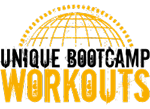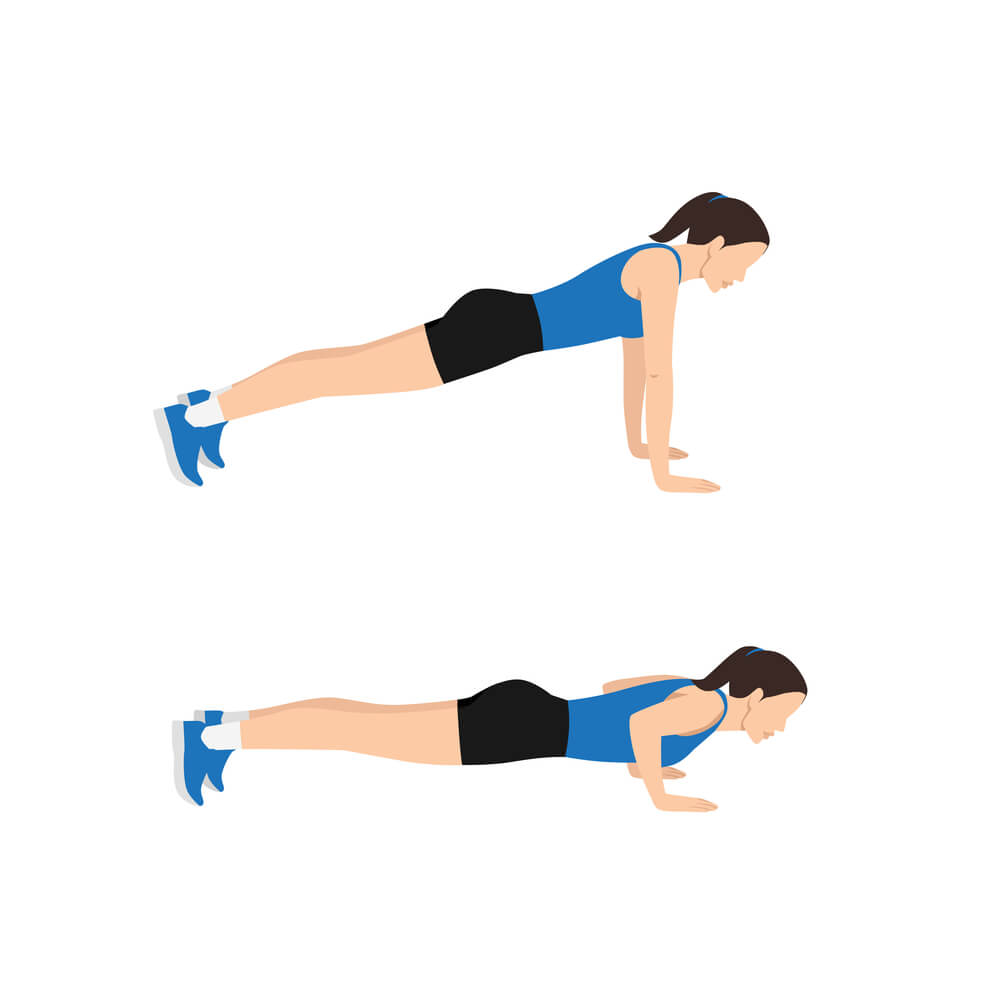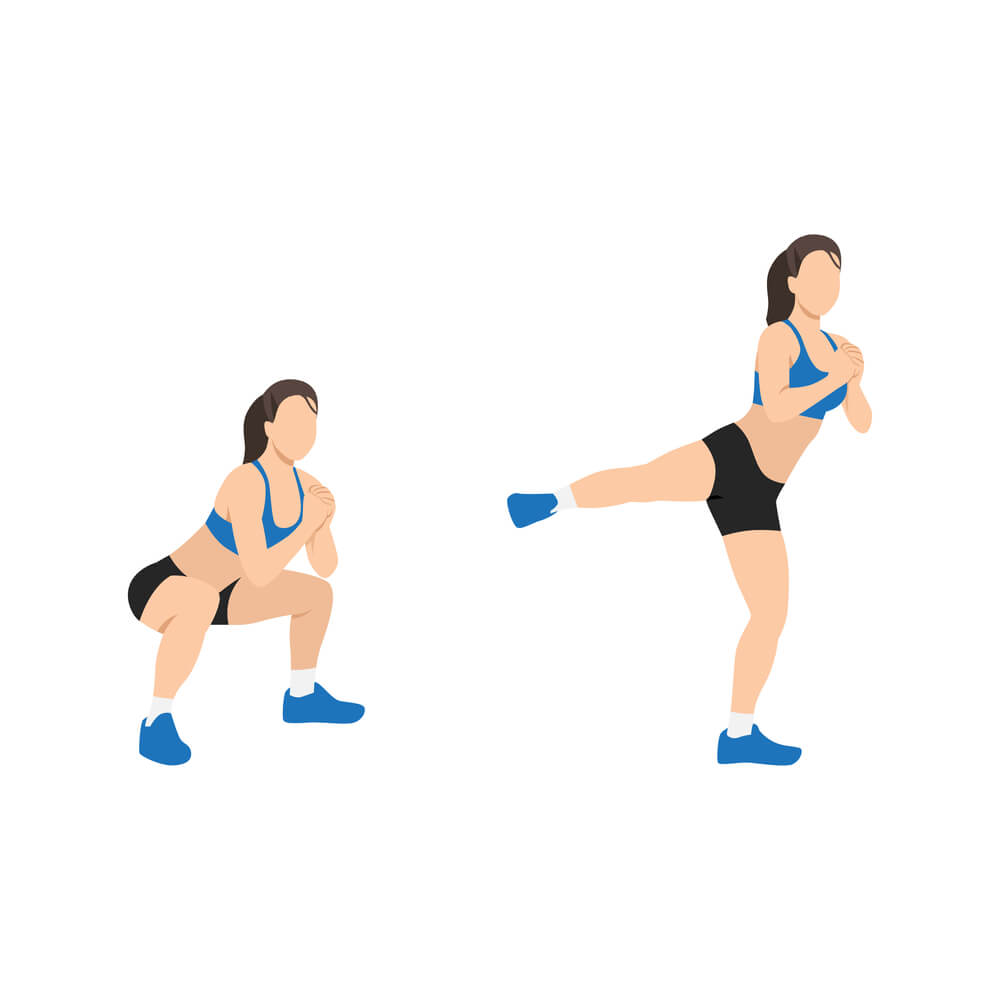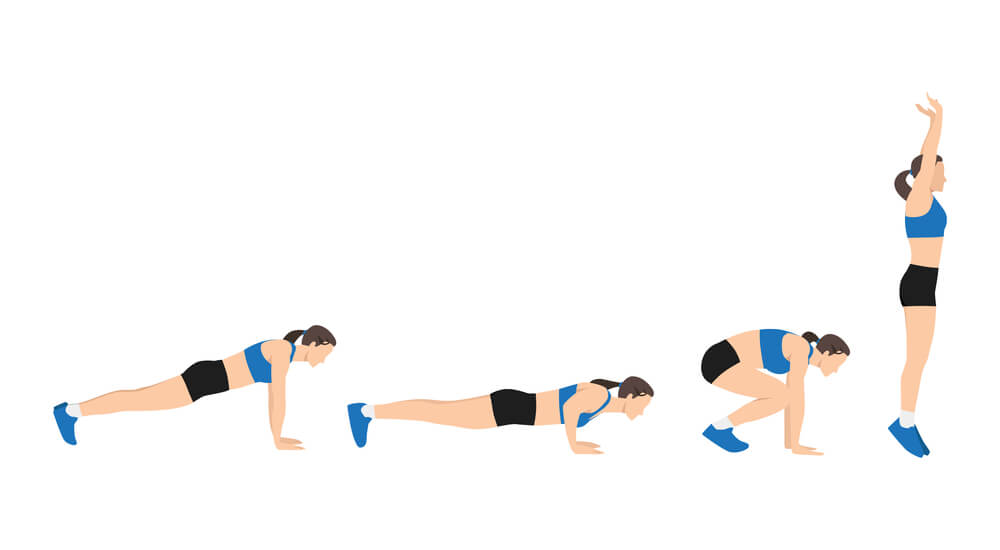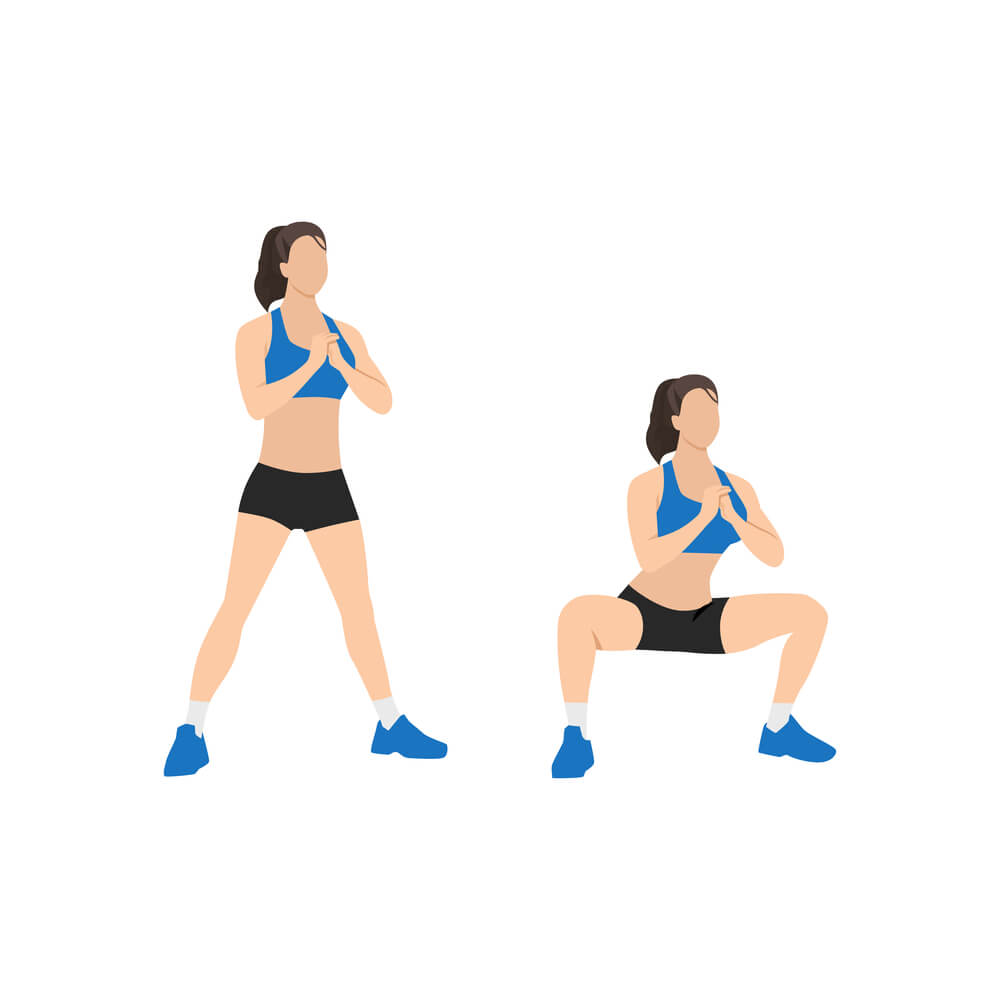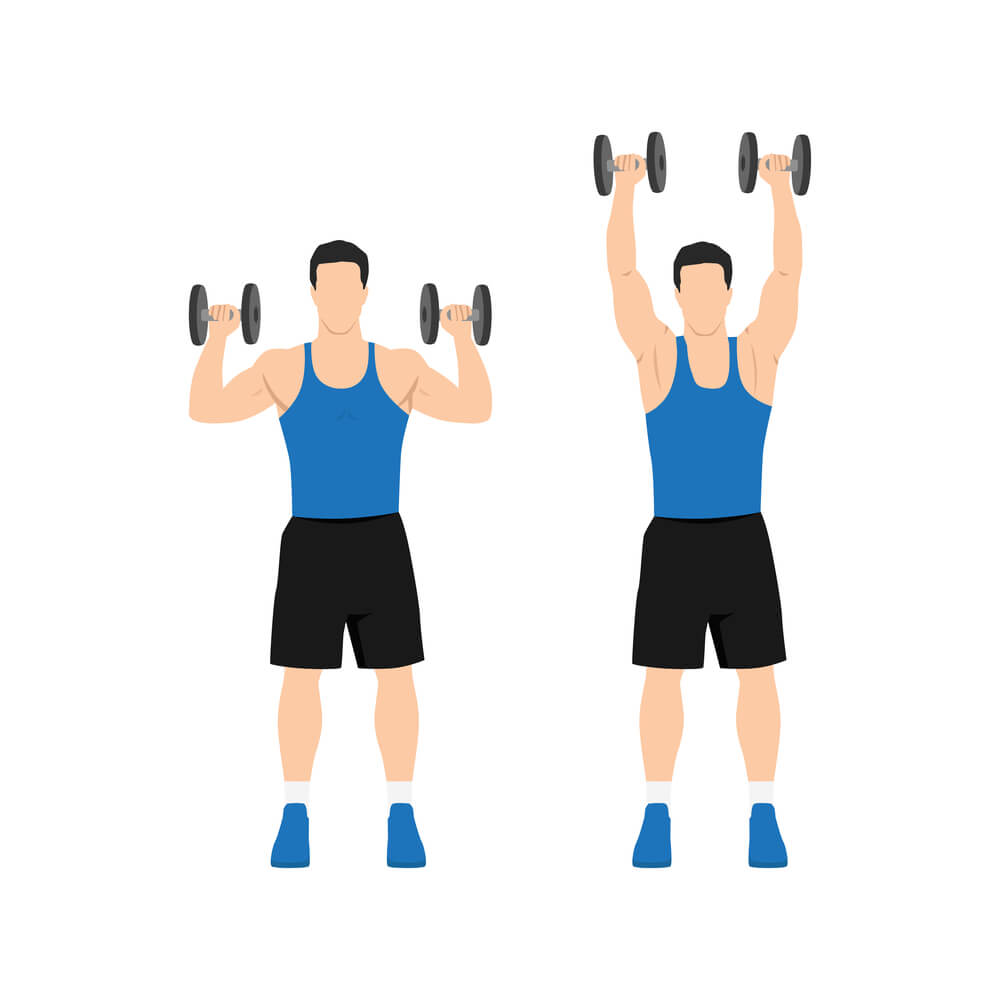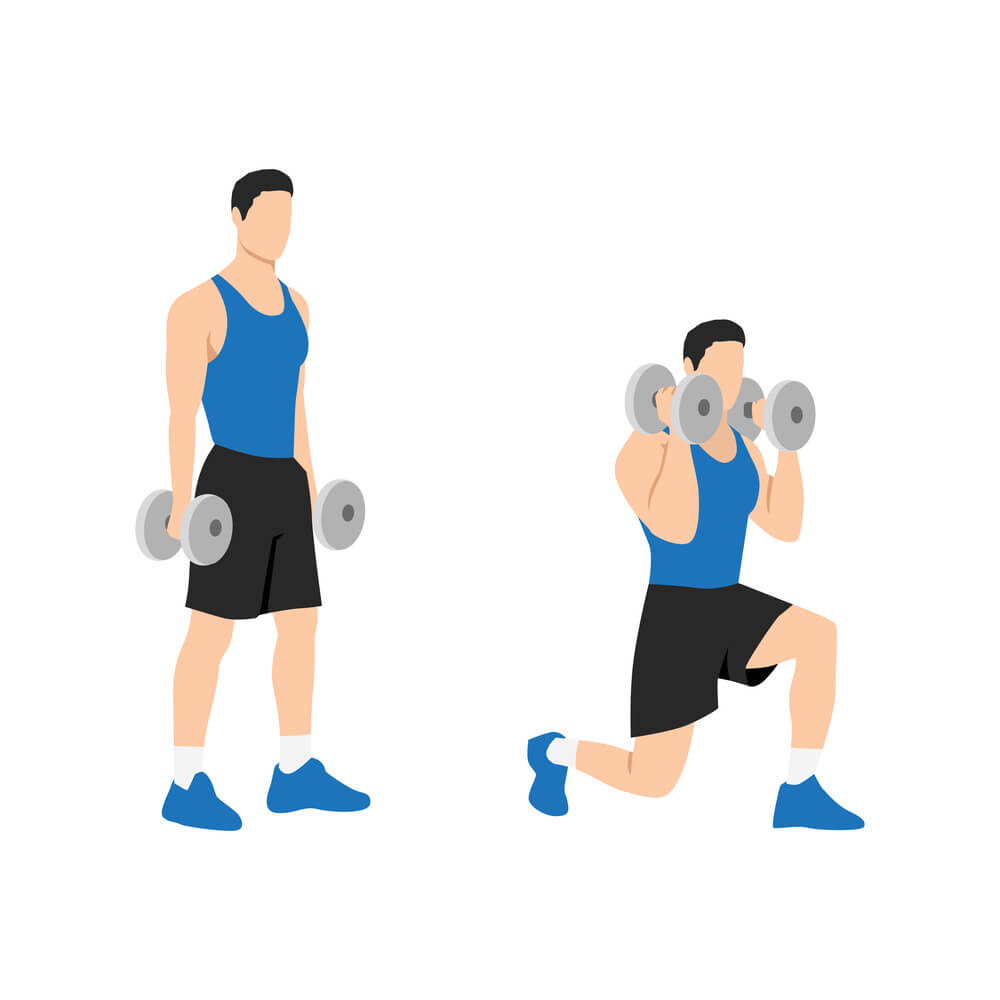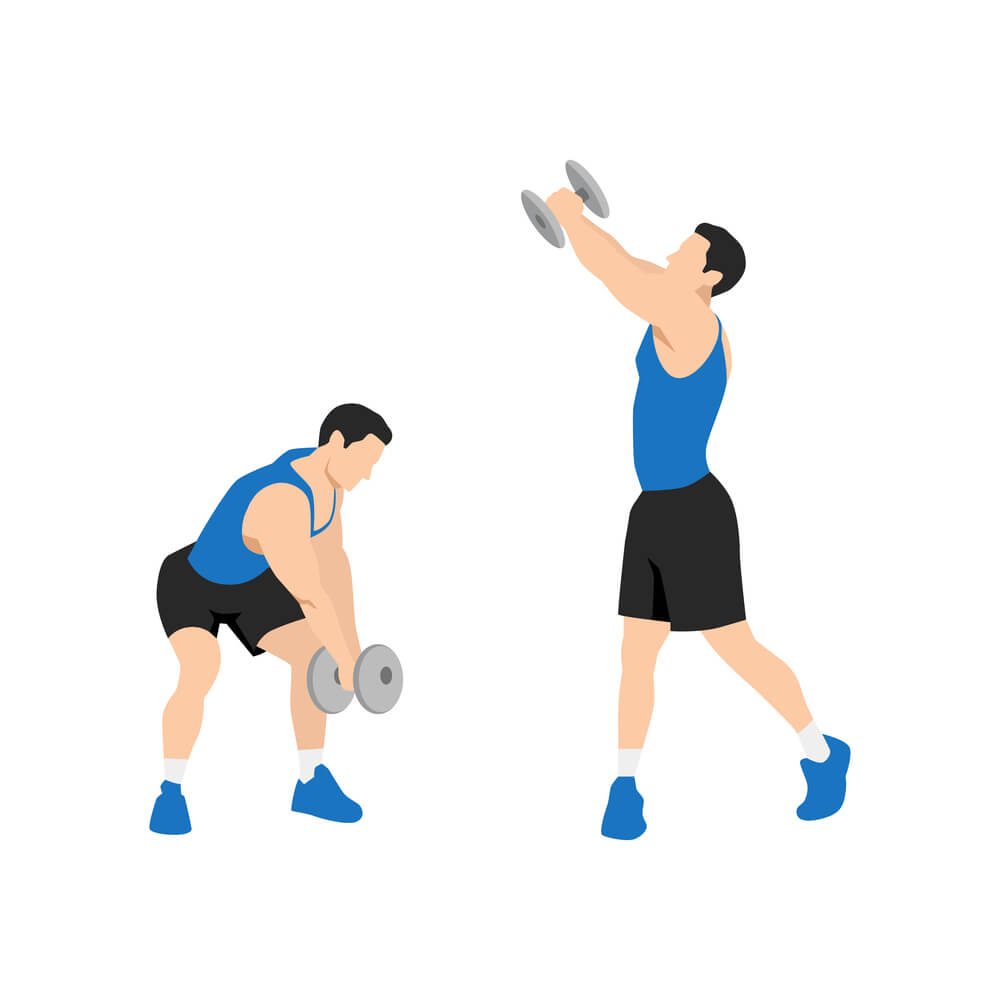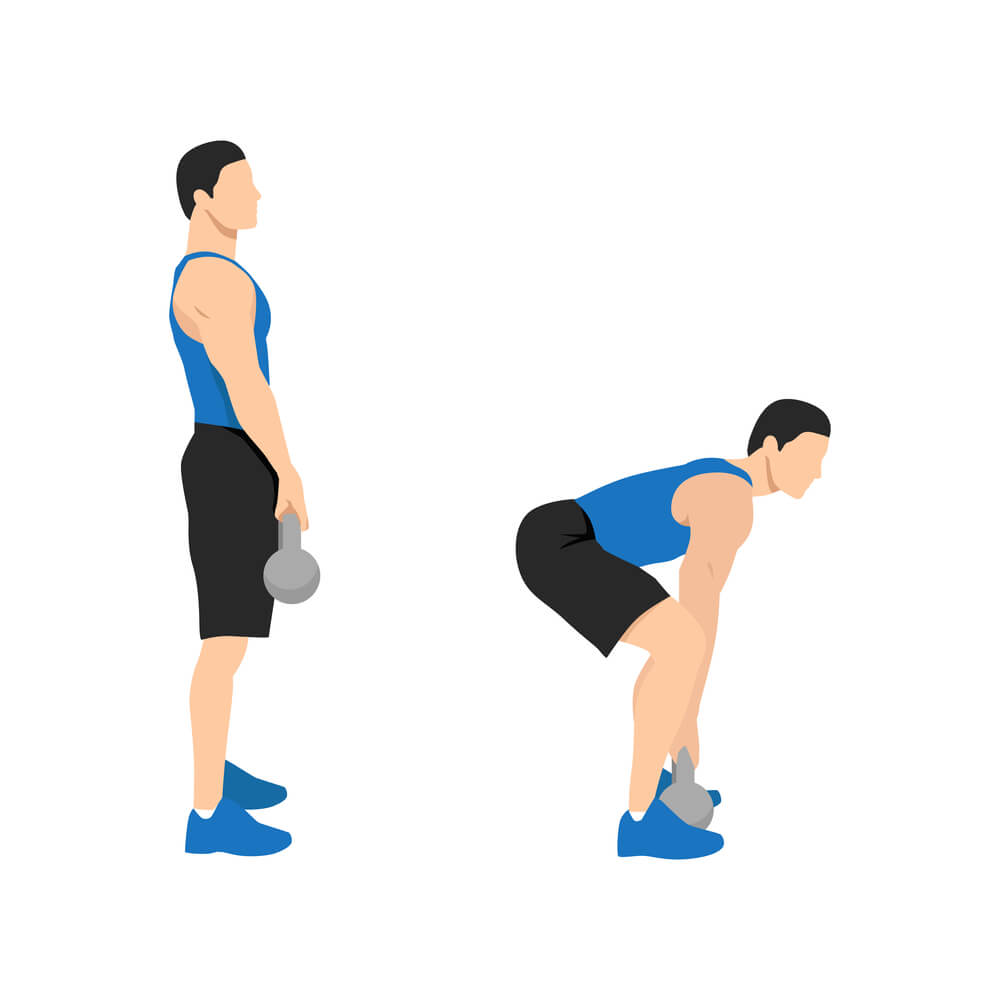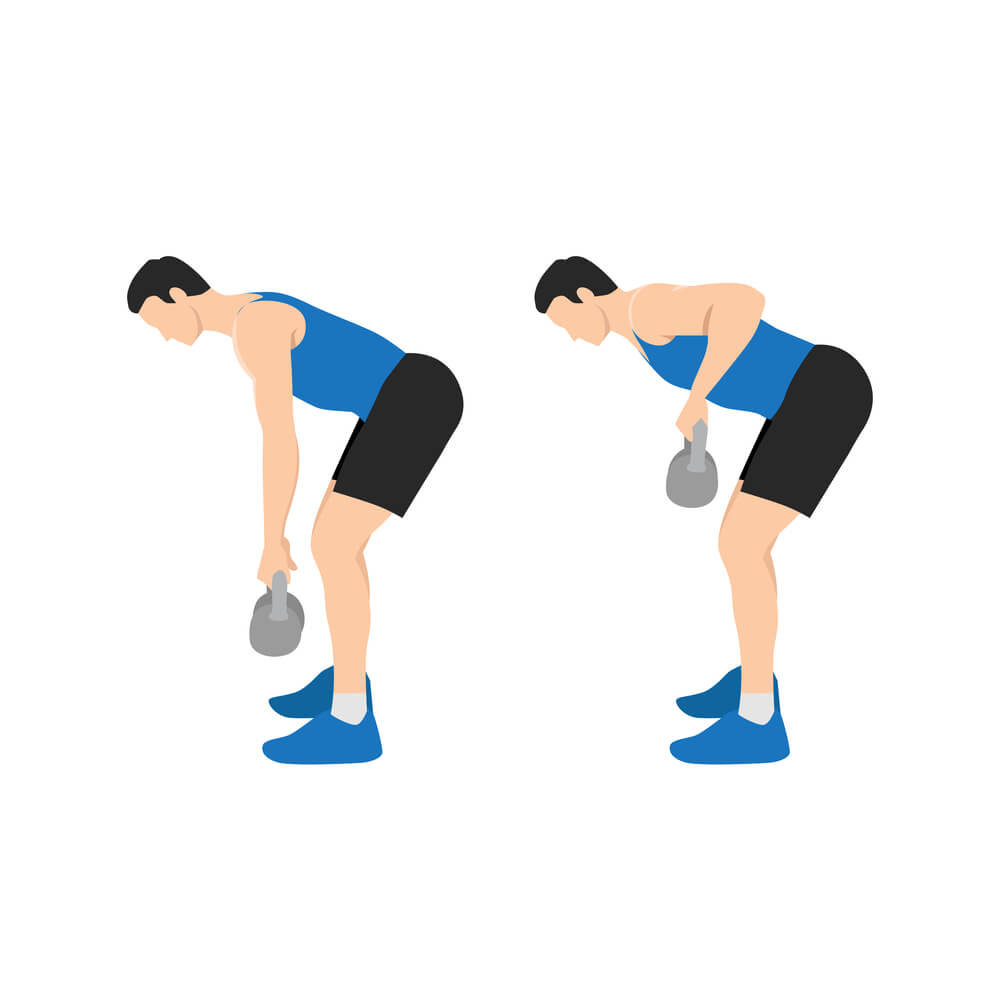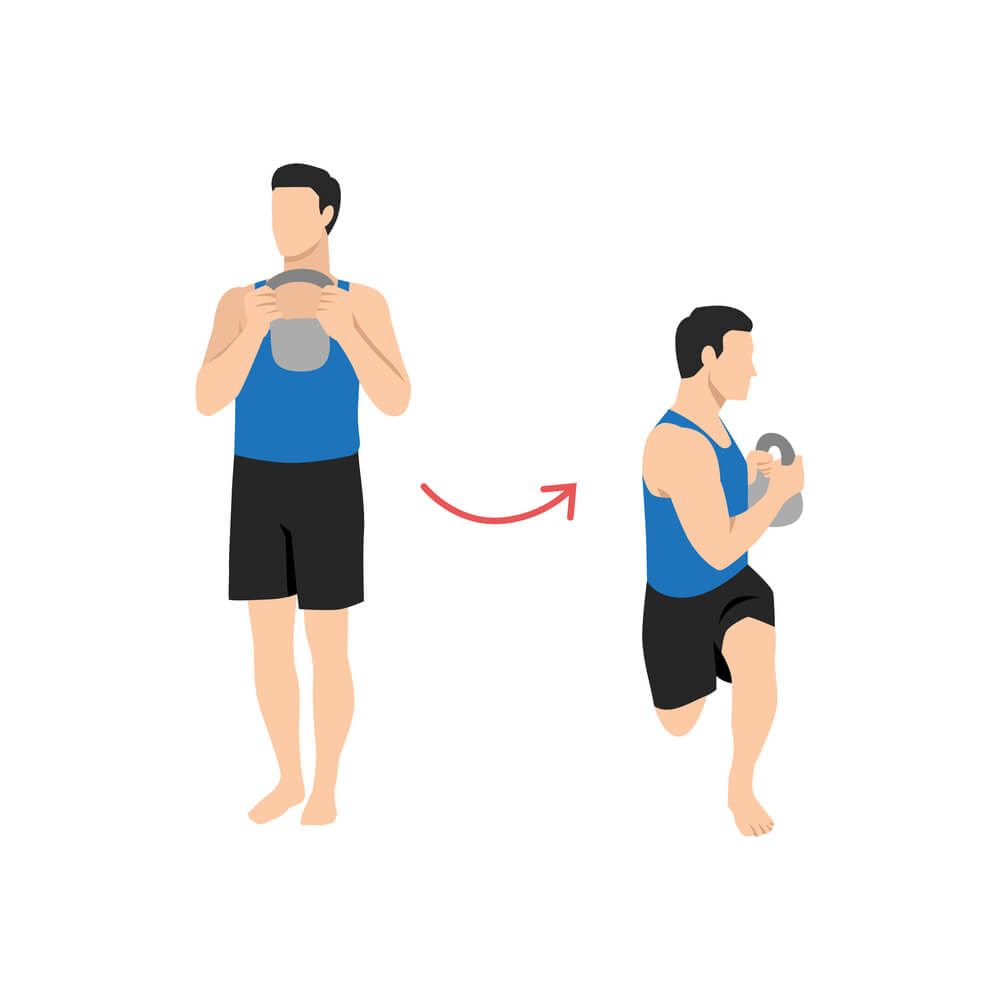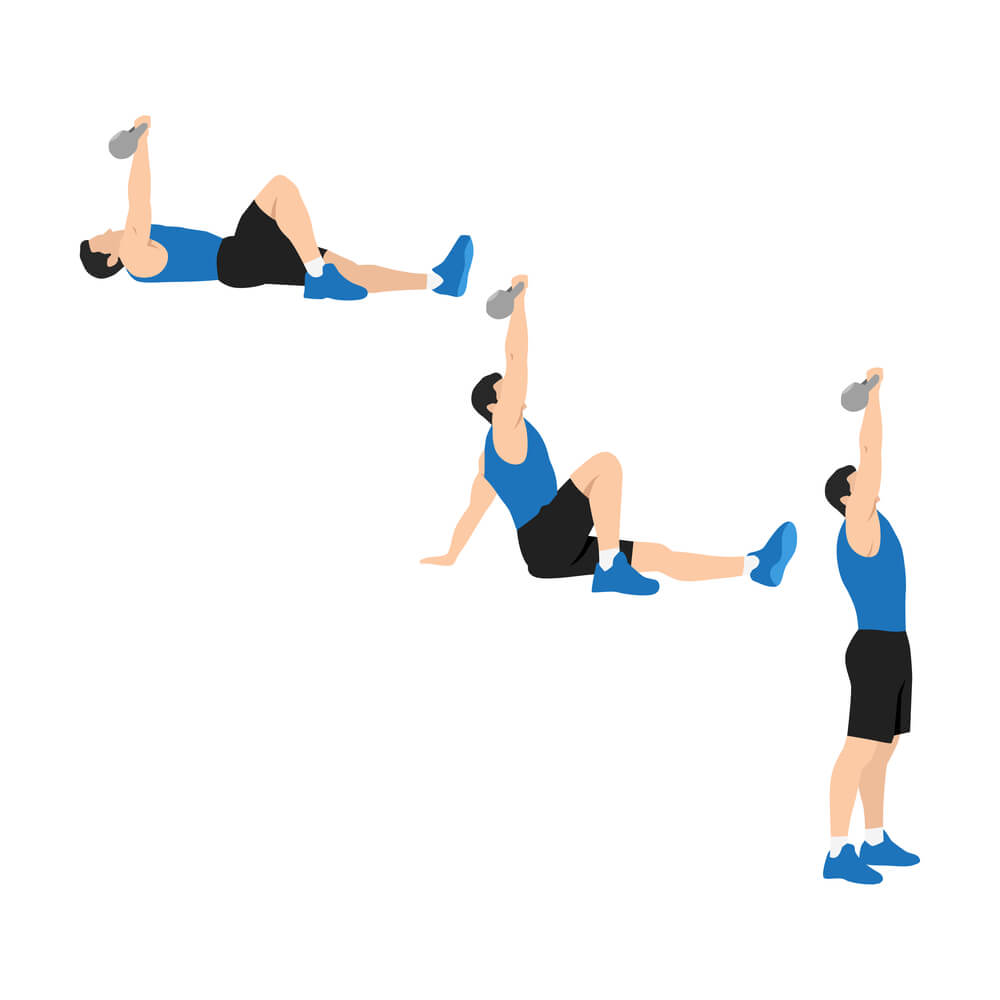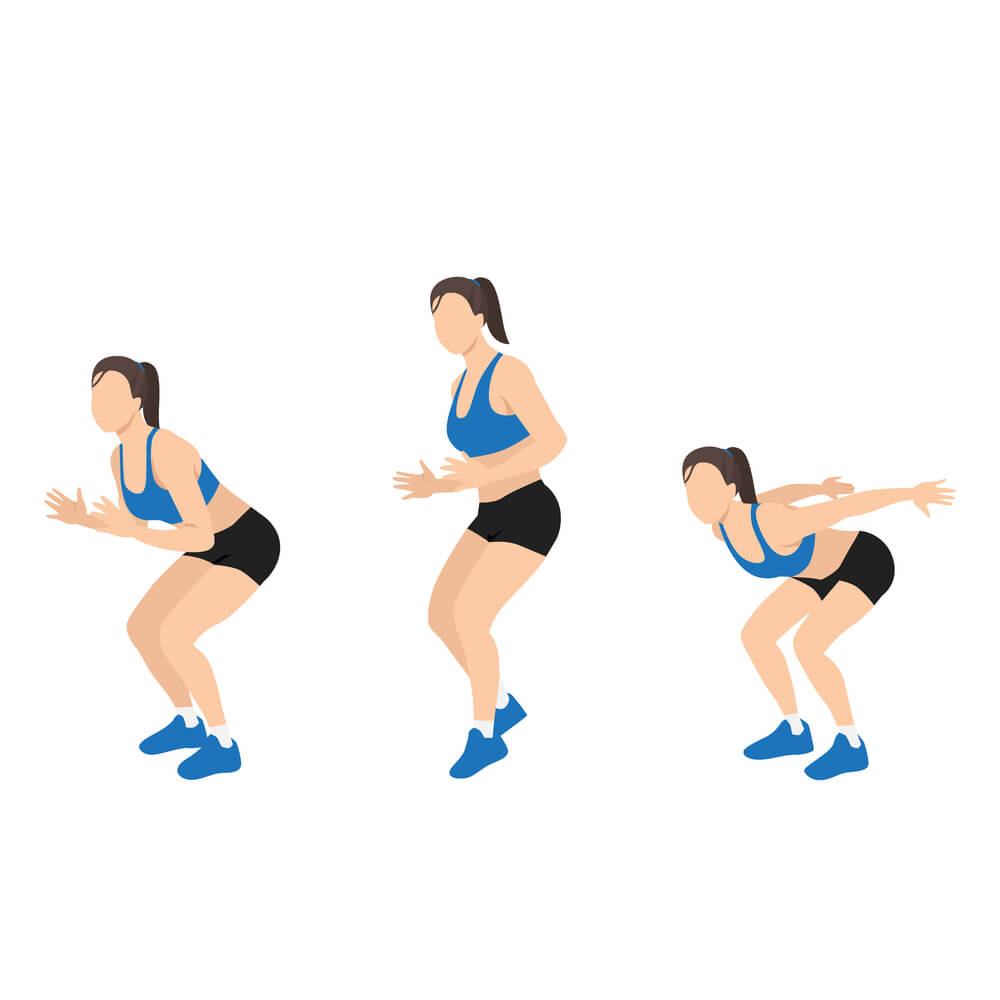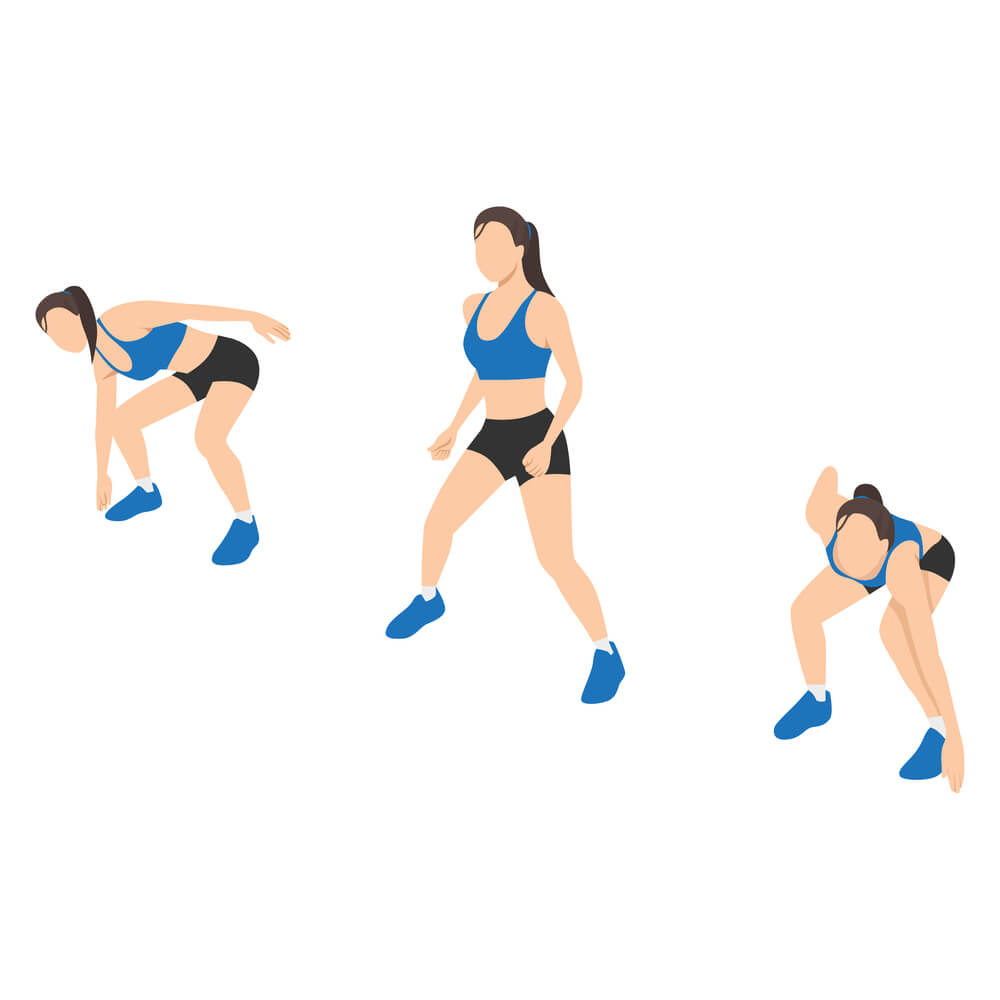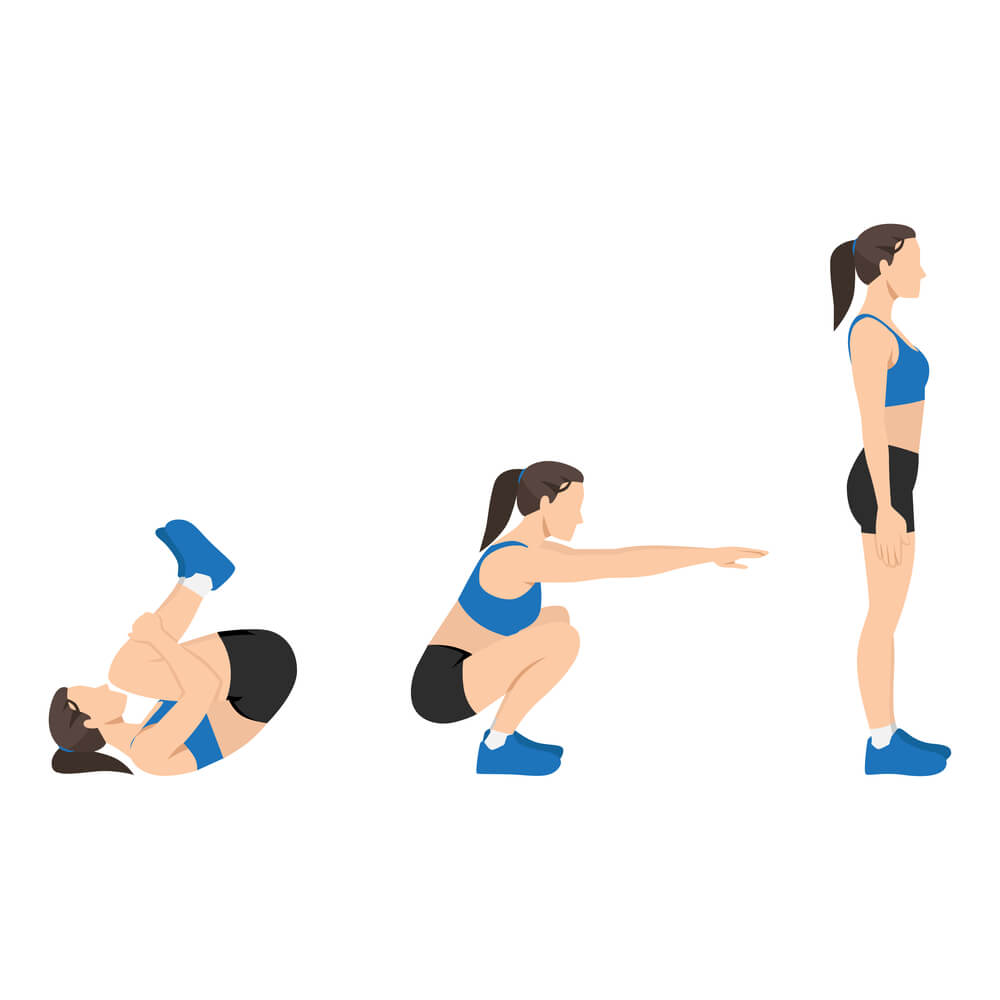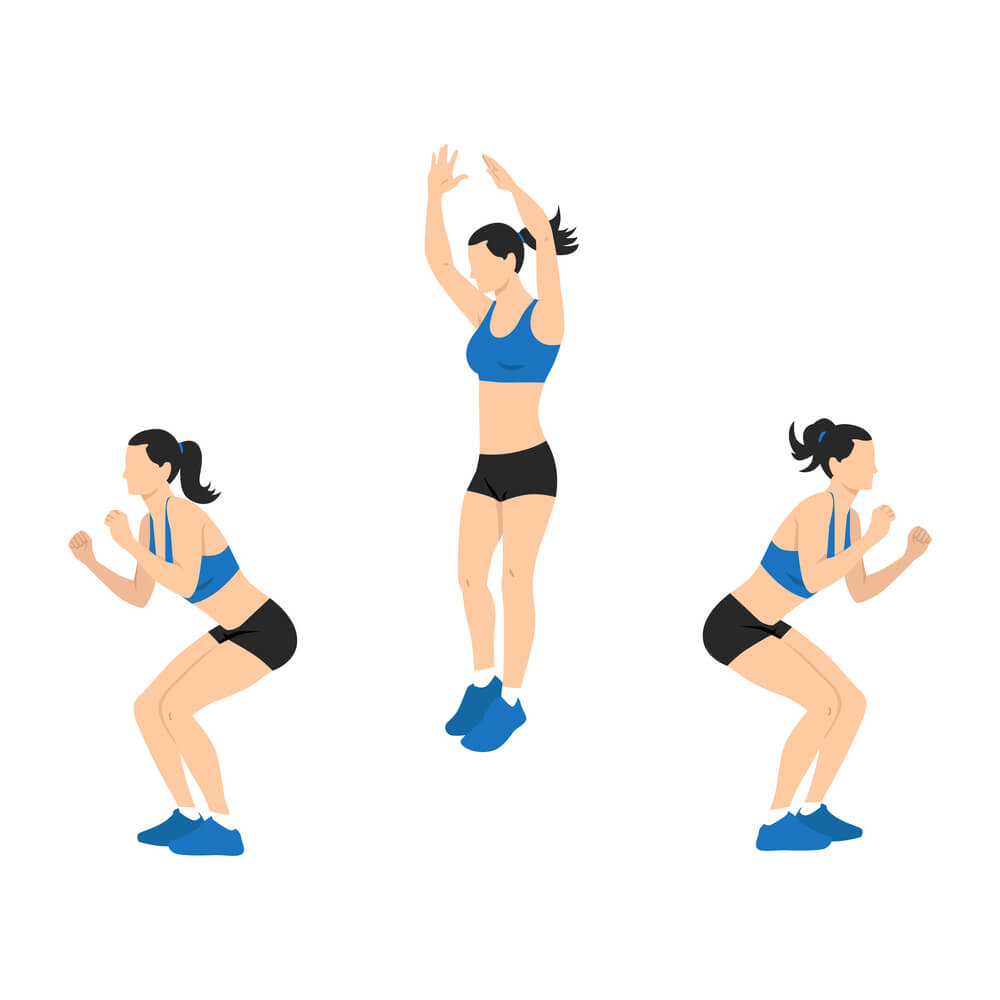In this guide, we'll explore a variety of bootcamp exercises for beginners, offering advanced techniques, new exercise variations, and creative programming ideas that will help you maintain your edge as a top-tier group fitness trainer.
Whether you're looking to introduce more variety into your workouts, enhance the effectiveness of your group fitness programme, or simply need fresh bootcamp ideas to keep your clients engaged, this guide will provide you with the tools and insights required to take your classes to the next level.
Let's start with...
Our Top 10 Bodyweight Bootcamp Exercises For Beginners
Bootcamp exercises for beginners should emphasise simplicity and effectiveness. By concentrating on basic bodyweight movements and lightweight exercises, you can create a dynamic and challenging workout without the need for equipment.
The following bootcamp exercises for beginners are perfect for building strength, improving cardiovascular health, and enhancing flexibility.
1: Plyo Jacks: Plyo Jacks, also known as Plyometric Jumping Jacks, are a high-intensity cardiovascular exercise that combines the benefits of traditional jumping jacks with plyometric (jumping) movements. This exercise effectively targets the entire body, particularly the legs, glutes, and core, while also improving cardiovascular fitness, coordination, and explosive power.
Description:
- Start by standing with your feet together and arms at your sides.
- Lower into a squat position by bending your knees and pushing your hips back, keeping your chest up and core engaged.
- From the squat position, explode upwards into a jump, spreading your legs out to the sides and bringing your arms overhead in a wide arc, similar to a jumping jack.
- Land softly back into the squat position with your feet together and arms at your sides.
- Repeat the movement for the desired number of repetitions or duration.
Benefits:
- Increases cardiovascular fitness and burns calories.
- Strengthens the legs, glutes, and core.
- Improves explosive power and coordination.
- Enhances overall body strength and endurance.
Modifications:
- Easier: Perform traditional jumping jacks without the squat or reduce the jump height.
- Harder: Increase the speed of the repetitions or add resistance by holding light dumbbells or wearing a weighted vest.
Plyo Jacks are an excellent choice for bootcamp exercises for beginners due to their dynamic nature and full-body engagement.
2: Push-Ups: Push-ups are a classic bodyweight exercise that primarily targets the chest, shoulders, and triceps while also engaging the core and lower body for stabilisation. This versatile exercise can be performed anywhere and is effective for building upper body strength and endurance.
Description:
- Start in a high plank position with your hands placed slightly wider than shoulder-width apart. Your body should form a straight line from your head to your heels.
- Engage your core, glutes, and legs to maintain a rigid body position throughout the movement.
- Lower your body toward the ground by bending your elbows, keeping them close to your body or flaring them out at a 45-degree angle.
- Continue lowering until your chest is just above the ground or as low as you can comfortably go while maintaining good form.
- Push through your hands to straighten your arms and return to the starting position.
- Repeat for the desired number of repetitions.
Benefits:
- Strengthens the chest, shoulders, and triceps.
- Engages the core for stabilisation.
- Improves upper body strength and muscular endurance.
- Can be modified for different fitness levels and goals.
Modifications:
Easier:
- Perform push-ups on your knees, keeping a straight line from your head to your knees.
- Elevate your hands on a bench or step to reduce the amount of body weight you are lifting.
Harder:
- Elevate your feet on a bench or step to increase the difficulty.
- Add a clap at the top of the push-up for a plyometric variation.
- Perform push-ups with one hand on a medicine ball for added instability.
Push-ups are a staple in bootcamp exercises for beginners, with numerous variations such as knee push-ups, incline push-ups, and diamond push-ups to suit different fitness levels and goals.
3: Mountain Climbers: Mountain Climbers are a dynamic, full-body exercise that primarily target the core muscles while also engaging the shoulders, chest, and legs. This high-intensity movement improves cardiovascular fitness, endurance, and agility.
Description:
- Start in a high plank position with your hands directly under your shoulders, arms straight, and body forming a straight line from head to heels.
- Engage your core to maintain a stable position.
- Quickly drive your right knee toward your chest, keeping your left leg extended.
- Switch legs rapidly, driving your left knee toward your chest while extending your right leg back to the starting position.
- Continue alternating legs at a quick pace, as if you are running in place in a plank position.
- Maintain a consistent speed and keep your hips level throughout the exercise.
Benefits:
- Strengthens the core, shoulders, and legs.
- Increases cardiovascular fitness and burns calories.
- Enhances agility, coordination, and overall endurance.
- Can be performed anywhere with no equipment needed.
Modifications:
Easier:
- Slow down the pace to focus on form and control.
- Elevate your hands on a bench or step to reduce the intensity.
Harder:
- Increase the speed for a more intense cardio workout.
- Add a resistance band around your feet for added resistance.
- Perform the exercise with your hands on an unstable surface like a medicine ball for added core engagement.
Mountain Climbers are a great addition to bootcamp exercises for beginners due to their effectiveness in engaging multiple muscle groups and enhancing overall fitness levels.
4: Squat Kicks: Squat Kicks combine the benefits of traditional squats with the added challenge of a kick, effectively targeting the lower body muscles while also engaging the core and improving balance and coordination. This dynamic exercise helps build strength, flexibility, and cardiovascular fitness.
Description:
- Stand with your feet shoulder-width apart, toes pointing slightly outward, and hands clasped in front of your chest for balance.
- Lower into a squat by bending your knees and pushing your hips back, keeping your chest up and core engaged. Your thighs should be parallel to the ground, and your knees should not extend past your toes.
- As you stand back up from the squat, shift your weight onto your left leg and kick your right leg forward (or you can kick to the side), keeping your core tight for balance.
- Return your right leg to the ground and immediately lower into another squat.
- Repeat the movement, this time kicking your left leg forward as you stand up.
- Continue alternating legs with each squat and kick for the desired number of repetitions.
Benefits:
- Strengthens the quads, hamstrings, glutes, and core.
- Improves balance, coordination, and flexibility.
- Enhances lower body strength and muscle tone.
- Increases cardiovascular fitness and burns calories.
Modifications:
Easier:
- Perform the squats without the kicks, focusing on proper squat form.
- Reduce the depth of the squat or the height of the kick.
Harder:
- Hold a dumbbell in each hand or a kettlebell at your chest for added resistance.
- Increase the speed of the movement for a more intense cardio workout.
- Add a jump as you come out of the squat before kicking for a plyometric variation.
Squat Kicks are an ideal choice for bootcamp exercises for beginners, as they offer a comprehensive workout that boosts both strength and agility.
5: Plank: The Plank on Knees is a modified version of the traditional plank that is less intense but still effective for strengthening the core muscles. This variation is ideal for beginners or individuals building up their core strength.
Description:
- Start by lying face down on the floor. Position your elbows directly under your shoulders and place your forearms flat on the ground. Your hands should be aligned with your elbows, forming a straight line.
- Engage your core and lift your torso and upper thighs off the ground, supporting your weight on your forearms and knees. Your body should form a straight line from your head to your knees.
- Keep your neck neutral by looking at the floor. Avoid arching your back or letting your hips sag.
- Hold this position, maintaining a strong and stable core, for the desired duration.
Benefits:
- Strengthens the core, including the abdominal muscles, obliques, and lower back.
- Improves posture and stability.
- Enhances overall body strength.
- Serves as a foundational exercise for more advanced plank variations.
Modifications:
Easier:
- Perform the exercise for shorter durations and gradually increase the time as your core strength improves.
- Rest in between sets as needed.
Harder:
- Increase the duration of the hold as your core strength improves.
- Progress to a full plank on your toes once you can comfortably hold the plank on knees with proper form.
- Add leg lifts: While holding the plank on knees, lift one leg at a time for a few seconds to engage the glutes and add an extra challenge to your core.
6: Lunges: Bodyweight lunges are an effective lower body exercise that targets the quads, hamstrings, glutes, and calves. They also help improve balance, coordination, and flexibility. This exercise can be performed anywhere and is suitable for all fitness levels.
Description:
- Stand tall with your feet hip-width apart and hands on your hips or clasped in front of your chest for balance.
- Step forward with your right leg, lowering your hips until both knees are bent at about 90 degrees. Your back knee should hover just above the ground, and your front knee should be directly above your ankle.
- Push through the heel of your right foot to return to the starting position.
- Repeat the movement with your left leg, stepping forward into a lunge.
- Continue alternating legs for the desired number of repetitions.
Benefits:
- Strengthens the quads, hamstrings, glutes, and calves.
- Improves balance, coordination, and flexibility.
- Enhances lower body strength and muscle tone.
- Can be performed anywhere without the need for equipment.
Modifications:
Easier:
- Perform reverse lunges instead of forward lunges to reduce strain on the knees. Step backward into the lunge rather than forward.
- Hold onto a stable surface for additional balance support.
Harder:
- Add a jump at the top of the lunge to create a plyometric lunge, increasing cardiovascular intensity.
- Hold a dumbbell in each hand or a kettlebell at your chest for added resistance.
- Perform walking lunges, continuously stepping forward with each lunge instead of returning to the starting position.
Lunges are an essential part of bootcamp exercises for beginners, offering a straightforward yet impactful way to build lower body strength and stability.
7: Burpees: Burpees are a high-intensity, full-body exercise that combines strength and cardio. This dynamic movement targets multiple muscle groups, including the chest, shoulders, arms, core, glutes, and legs, while also improving cardiovascular fitness and endurance.
Description:
- Start by standing with your feet shoulder-width apart and your arms at your sides.
- Lower into a squat position, placing your hands on the floor in front of you.
- Jump your feet back to land in a high plank position, keeping your body in a straight line from head to heels. Engage your core to maintain stability.
- Perform a push-up by lowering your chest to the ground and then pushing back up to the high plank position.
- Jump your feet forward, returning to the squat position with your hands still on the ground.
- Explosively jump up into the air, reaching your arms overhead.
- Land softly and immediately lower into the next repetition.
Benefits:
- Strengthens the chest, shoulders, arms, core, glutes, and legs.
- Increases cardiovascular fitness and burns a high number of calories.
- Enhances coordination, agility, and explosive power.
- Can be performed anywhere without the need for equipment.
Modifications:
Easier:
- Eliminate the push-up and perform a plank instead.
- Step back into the plank position one foot at a time instead of jumping.
- Skip the jump at the end and simply stand up.
Harder:
- Add a tuck jump at the end of the burpee, bringing your knees to your chest.
- Perform a chest-to-floor push-up for increased intensity.
- Hold a pair of dumbbells while performing the burpees for added resistance.
Burpees are a vital component of bootcamp exercises for beginners, providing an all-encompassing workout that enhances overall fitness and stamina.
8: Standing Mountain Climbers: Standing Mountain Climbers are a variation of the traditional mountain climbers that are performed in a standing position. This exercise targets the core, legs, and arms, and also improves cardiovascular fitness, coordination, and agility. It's a great option for those who prefer a lower-impact workout or need a break from floor exercises.
Description:
- Stand tall with your feet hip-width apart and your arms at your sides.
- Raise your right arm overhead while simultaneously lifting your left knee towards your chest, engaging your core.
- Quickly switch positions, bringing your right knee up and your left arm overhead, as if you are climbing.
- Continue to alternate legs and arms in a running motion, keeping your movements quick and controlled.
- Maintain a steady pace and ensure your core remains engaged throughout the exercise.
Benefits:
- Strengthens the core, legs, and arms.
- Improves cardiovascular fitness and burns calories.
- Enhances coordination, agility, and balance.
- Provides a lower-impact alternative to traditional mountain climbers.
Modifications:
Easier:
- Slow down the pace to focus on form and control.
- Lift your knees only as high as comfortable and reduce the range of motion.
Harder:
- Increase the speed of the movement for a more intense cardio workout.
- Add a small hop with each leg lift to increase the intensity.
- Hold light dumbbells in your hands for added resistance.
Standing Mountain Climbers are ideal for bootcamp exercises for beginners, offering an effective and accessible way to build strength and endurance without high impact on the joints.
9: Sit-Ups: Sit-ups are a classic core exercise that primarily target the abdominal muscles, including the rectus abdominis, obliques, and hip flexors. This exercise is effective for building core strength and improving overall abdominal muscle tone.
Description:
- Start by lying on your back with your knees bent and feet flat on the floor, about hip-width apart. Place your hands behind your head with your elbows pointing out to the sides, or cross your arms over your chest.
- Engage your core by drawing your belly button toward your spine.
- Exhale as you lift your upper body off the ground, curling your spine towards your knees. Keep your chin slightly tucked and avoid pulling on your neck.
- Continue lifting until your upper body is upright and your chest is close to your knees.
- Inhale as you lower your upper body back to the starting position in a controlled manner, ensuring your lower back touches the floor first.
- Repeat for the desired number of repetitions.
Benefits:
- Strengthens the abdominal muscles, including the rectus abdominis and obliques.
- Improves core stability and overall body strength.
- Enhances posture and balance.
- Can be performed anywhere without the need for equipment.
Modifications:
Easier:
- Perform crunches instead of full sit-ups, lifting only your shoulders off the ground.
- Use a stability ball under your lower back for added support and reduced range of motion.
Harder:
- Hold a weight plate or dumbbell against your chest to increase resistance.
- Perform sit-ups on an incline bench for added intensity.
- Add a twist at the top of the movement to engage the obliques further.
Sit-ups are a fundamental part of bootcamp exercises for beginners, providing an essential workout to develop strong and toned abs.
10. Leg Raises: Leg raises are an effective core exercise that primarily target the lower abdominal muscles, including the rectus abdominis and hip flexors. This exercise helps build core strength, improve stability, and enhance overall abdominal muscle tone.
Description:
- Start by lying flat on your back with your legs extended and your arms at your sides, palms facing down. You can place your hands under your glutes for added support.
- Engage your core by drawing your belly button towards your spine.
- Keeping your legs straight and together, lift them slowly towards the ceiling until they form a 90-degree angle with your torso. Your hips should remain in contact with the floor.
- Slowly lower your legs back down to the starting position, stopping just before your feet touch the ground to maintain tension in your core.
- Repeat for the desired number of repetitions.
Benefits:
- Strengthens the lower abdominal muscles and hip flexors.
- Improves core stability and overall body strength.
- Enhances posture and balance.
- Can be performed anywhere without the need for equipment.
Modifications:
Easier:
- Bend your knees slightly as you lift your legs to reduce the intensity.
- Perform single-leg raises, lifting one leg at a time.
Harder:
- Add ankle weights for increased resistance.
- Perform hanging leg raises using a pull-up bar for a more advanced variation.
- Add a hip lift at the top of the movement, raising your hips off the ground to engage the lower abs further.
Leg raises are a key component of bootcamp exercises for beginners, offering a simple yet impactful way to strengthen the lower abs and improve core stability.
11. Delayed Squats: Delayed Squats primarily work the quadriceps, glutes, hamstrings, and calves, while also improving explosive power and lower body strength. This exercise enhances muscle endurance and control by incorporating a pause at the bottom of the squat.
Description:
- Start standing with your feet shoulder-width apart, holding a dumbbell in each hand at your sides.
- Lower your body into a squat position by bending your knees and pushing your hips back. Keep your chest up and your back straight. Ensure your knees do not extend past your toes.
- Once you reach the bottom of the squat, pause and hold the position for a count of three seconds. Focus on maintaining tension in your muscles.
- Push through your heels to return to the starting position, fully extending your hips and knees. Focus on engaging your quadriceps and glutes as you rise.
- Repeat for the desired number of repetitions.
Benefits:
- Builds strength in the quadriceps, glutes, hamstrings, and calves.
- Enhances explosive power and lower body endurance.
- Improves joint flexibility and range of motion.
- Increases muscle control and stability.
Modifications:
Easier:
- Perform the exercise without dumbbells or use lighter weights.
- Reduce the pause time at the bottom of the squat.
- Squat to a higher position without going too deep.
Harder:
- Increase the weight of the dumbbells.
- Extend the pause time to five seconds or more.
- Add a jump at the top of the squat for a plyometric effect.
Delayed Squats are an excellent addition to bootcamp exercises for beginners, helping to build lower body strength and increase muscle stability through controlled movements.
The Top 20 Bootcamp Exercises For Beginners Using Dumbbells
Incorporating bootcamp exercises with weights such as dumbbells and kettlebells is a great way to introduce strength-based exercises into your group fitness programme. Here are some key advantages:
1: Increased Muscle Strength
Using weights like dumbbells and kettlebells helps in building and toning muscles. The added resistance forces your muscles to work harder, leading to increased strength and muscle growth over time.
2: Improved Functional Fitness
Dumbbell and kettlebell exercises often mimic everyday movements, improving functional fitness. This means better performance in daily activities and a reduced risk of injuries.
3: Enhanced Core Stability
Many exercises with dumbbells and kettlebells require engaging the core for stability, leading to a stronger and more stable core. This can improve posture and reduce the risk of lower back pain.
4: Progressive Overload
Dumbbells and kettlebells allow for progressive overload by gradually increasing the weight used. This principle is key for continuous improvement in strength and muscle mass, as it consistently challenges the muscles to adapt and grow.
Top 20 bootcamp exercises for beginners using dumbbells.
1: Dumbbell Thrusters: Dumbbell thrusters combine a squat and press movement, working the legs, core, shoulders, and arms.
Description: Hold a pair of dumbbells at shoulder height. Squat down until your thighs are parallel to the ground, then stand up explosively and press the dumbbells overhead.
- Benefits: Improves lower and upper body strength, and enhances cardiovascular fitness.
- Easier: Use lighter weights or perform a push press instead.
- Harder: Increase the weight or add a pause at the bottom of the squat.
This compound exercise effectively targets multiple muscle groups and enhances overall strength and endurance, making it a valuable addition to bootcamp exercises for beginners.
2: Dumbbell Squats: Dumbbell squats target the quadriceps, hamstrings, and glutes, adding resistance to boost muscle growth. They also engage the core muscles, improving stability and balance while enhancing overall lower body strength and endurance.
Description: Stand with feet shoulder-width apart, holding a dumbbell in each hand at your sides. Lower your hips back and down into a squat, keeping your chest up and knees behind your toes. Push back up to standing.
- Benefits: Strengthens the quads, hamstrings, glutes, and core, enhancing overall lower body strength and stability.
Modifications:
- Easier: Use lighter weights or perform bodyweight squats.
- Harder: Increase the weight or perform goblet squats with one dumbbell held at chest height.
Dumbbell squats are a key component of bootcamp exercises for beginners, offering a robust workout for developing lower body power and core stability.
3: Dumbbell Bicep Curls: Dumbbell bicep curls are essential for building bicep strength and definition. They improve arm muscle tone, increase upper body strength, and support the development of stronger forearms, contributing to better grip strength.
Description: Stand with feet shoulder-width apart, holding a dumbbell in each hand with palms facing forward. Curl the weights up towards your shoulders, keeping your elbows close to your torso. Lower the weights back down.
- Benefits: Strengthens the biceps, improves arm muscle tone, and supports upper body endurance.
Modifications:
- Easier: Use lighter weights or perform one arm at a time.
- Harder: Increase the weight or perform with a slower tempo.
Dumbbell bicep curls are an excellent addition to bootcamp exercises for beginners, helping to build upper body strength and improve muscle tone effectively.
4: Dumbbell Shoulder Press: The dumbbell shoulder press targets the deltoids, triceps, and upper chest. It helps in building strong and defined shoulders, improving upper body strength, and enhancing overhead pressing ability and stability.
Description: Stand with feet shoulder-width apart, holding a dumbbell in each hand at shoulder height with palms facing forward. Press the weights overhead until your arms are fully extended, then lower them back down.
- Benefits: Strengthens the shoulders, triceps, and upper chest, enhancing upper body strength and stability.
Modifications:
- Easier: Use lighter weights or perform seated.
- Harder: Increase the weight or perform with alternating arms.
The dumbbell shoulder press is a valuable exercise in bootcamp exercises for beginners, aiding in the development of strong, defined shoulders and overall upper body strength.
5: Dumbbell Chest Press: The dumbbell chest press primarily targets the pectoral muscles, along with the triceps and shoulders. It helps build upper body strength, enhance muscle definition, and improve pushing power.
Description: Lie on your back on a bench or the floor with a dumbbell in each hand. Position the weights at chest level with palms facing forward. Press the weights upward until your arms are fully extended, then lower them back down.
- Benefits: Strengthens the chest, shoulders, and triceps, improving upper body strength and muscle definition.
Modifications:
- Easier: Use lighter weights.
- Harder: Increase the weight or perform with a single arm.
The dumbbell chest press is an important exercise in bootcamp exercises for beginners, aiding in the development of upper body strength and muscle definition.
6: Dumbbell Rows: Dumbbell rows are effective for targeting the upper back, lats, and biceps. They enhance upper body strength, improve posture, and support the development of a strong back.
Description: Stand with feet hip-width apart, holding a dumbbell in each hand. Bend at the hips and knees slightly, keeping your back straight. Pull the dumbbells towards your torso, squeezing your shoulder blades together, then lower them back down.
- Benefits: Strengthens the upper back, lats, and biceps, enhancing upper body strength and posture.
Modifications:
- Easier: Use lighter weights or perform with one arm supported on a bench.
- Harder: Increase the weight or perform single-arm rows.
Dumbbell rows are a key component of bootcamp exercises for beginners, enhancing upper body strength and improving posture effectively.
7: Dumbbell Deadlifts: Dumbbell deadlifts target the hamstrings, glutes, lower back, and core. They help build lower body and back strength, improve posture, and enhance overall functional fitness.
Description: Stand with feet hip-width apart, holding a dumbbell in each hand in front of your thighs. Keeping your back straight, hinge at the hips to lower the weights towards the floor, then return to standing.
- Benefits: Strengthens the hamstrings, glutes, lower back, and core, improving lower body and back strength.
Modifications:
- Easier: Use lighter weights or perform with a limited range of motion.
- Harder: Increase the weight or perform single-leg deadlifts.
Dumbbell deadlifts are essential in bootcamp exercises for beginners, helping to build lower body and back strength while improving posture and core stability.
8: Dumbbell Lunge Curl: Dumbbell Lunge Curls combine the benefits of lunges and hammer curls, effectively targeting the quads, hamstrings, glutes, and biceps while enhancing balance and coordination. This exercise helps build lower body strength, improve muscle tone, and increase functional movement.
Description:
- Stand with your feet together, holding a dumbbell in each hand at your sides.
- Step forward with one leg, lowering your hips until both knees are bent at about 90 degrees. Your back knee should hover just above the ground, and your front knee should not extend past your toes.
- As you lower into the lunge, perform a hammer curl by curling the dumbbells to your shoulders, keeping your palms facing each other.
- Lower the dumbbells back to your sides as you push back up to the starting position.
- Repeat the movement, alternating legs with each lunge.
Benefits:
- Strengthens the quads, hamstrings, glutes, and biceps.
- Improves balance and coordination.
- Enhances lower body strength and muscle tone.
- Increases functional movement.
Modifications:
- Easier: Use lighter weights or perform reverse lunges (stepping back instead of forward).
- Harder: Increase the weight of the dumbbells or perform walking lunges (moving forward with each lunge instead of returning to the starting position).
Dumbbell Lunge Curls are a versatile addition to bootcamp exercises for beginners, offering a comprehensive workout that enhances lower body strength, muscle tone, and overall coordination.
9: Dumbbell Lateral Raises: Dumbbell lateral raises focus on the lateral deltoids, helping to build shoulder width and definition. They improve shoulder strength and stability, contributing to better upper-body aesthetics.
Description: Stand with feet shoulder-width apart, holding a dumbbell in each hand at your sides. Raise the weights out to the sides until your arms are parallel to the floor, then lower them back down.
- Benefits: Strengthens the shoulders and improves shoulder stability and definition.
Modifications:
- Easier: Use lighter weights or perform with bent arms.
- Harder: Increase the weight or perform with a slower tempo.
Dumbbell lateral raises are a valuable exercise in bootcamp exercises for beginners, helping to build shoulder width, strength, and stability effectively.
10: Dumbbell Tricep Extensions: Dumbbell tricep extensions target the triceps, improving upper arm strength and definition. They enhance arm muscle tone and contribute to better-pushing movements.
Description: Stand with feet shoulder-width apart, holding a dumbbell with both hands overhead. Lower the weight behind your head by bending your elbows, then extend your arms back up.
- Benefits: Strengthens the triceps and improves upper arm muscle definition and strength.
Modifications:
- Easier: Use a lighter weight or perform with one arm at a time.
- Harder: Increase the weight or perform with a single arm.
Dumbbell tricep extensions are a crucial part of bootcamp exercises for beginners, helping to improve upper arm strength and enhance muscle tone effectively.
11: Single Dumbbell Wood Chopper: The Single Dumbbell Wood Chopper is a dynamic exercise that targets the core, particularly the obliques, while also engaging the shoulders and legs. This movement mimics the motion of chopping wood, enhancing rotational power and functional strength.
Description:
- Stand with your feet shoulder-width apart, holding a dumbbell with both hands. Grip the dumbbell at one end, like a baseball bat.
- Begin in a squat position with the dumbbell held outside your right knee, keeping your back straight and core engaged.
- In one smooth motion, lift the dumbbell diagonally across your body as you stand up, rotating your torso and pivoting on your right foot. Finish with the dumbbell above your left shoulder, extending your arms fully.
- Reverse the motion, bringing the dumbbell back down to the starting position by your right knee.
- Perform the desired number of repetitions on one side, then switch to the other side.
Benefits:
- Strengthens the core, particularly the obliques.
- Enhances rotational power and functional strength.
- Engages the shoulders, legs, and stabilizing muscles.
- Improves coordination and balance.
Modifications:
- Easier: Use a lighter weight or reduce the range of motion.
- Harder: Increase the weight of the dumbbell or perform the exercise at a faster pace while maintaining control.
The Single Dumbbell Wood Chopper is an excellent addition to bootcamp exercises for beginners, providing a dynamic workout that targets the core, shoulders, and legs effectively.
12: Dumbbell Snatch: The One-Arm Dumbbell Snatch is a powerful full-body exercise that primarily targets the shoulders, back, and legs while also engaging the core. This explosive movement enhances strength, power, and coordination.
Description:
- Stand with your feet shoulder-width apart, holding a dumbbell in your right hand with an overhand grip. Your arm should be fully extended, and the dumbbell should be in front of your thighs.
- Lower into a partial squat by bending your knees and hips, keeping your chest up and back straight. The dumbbell should be positioned between your knees.
- In one explosive motion, push through your heels to extend your hips and knees while simultaneously pulling the dumbbell upward. Keep the dumbbell close to your body as it moves upward.
- As the dumbbell reaches shoulder height, rotate your elbow underneath it, catching the dumbbell overhead with your arm fully extended. Your knees should be slightly bent to absorb the impact.
- Stand up straight, bringing your legs together and stabilizing the dumbbell overhead.
- Lower the dumbbell back to the starting position in a controlled manner.
- Repeat for the desired number of repetitions, then switch to the left hand and repeat.
Benefits:
- Strengthens the shoulders, back, legs, and core.
- Enhances explosive power and coordination.
- Improves cardiovascular fitness and burns calories.
- Develops full-body functional strength.
Modifications:
Easier:
- Use a lighter dumbbell to start with, focusing on mastering the technique.
- Break down the movement into two parts: first practice the high pull, then the catch phase separately.
Harder:
- Use a heavier dumbbell to increase the intensity.
- Perform the exercise at a faster pace while maintaining proper form to increase cardiovascular challenge.
- Add a squat at the catch phase to engage the legs even more.
The One-Arm Dumbbell Snatch is a valuable part of bootcamp exercises for beginners, providing a powerful full-body workout that effectively targets the shoulders, back, legs, and core.
13: Power Thruster: The Dumbbell Deadlift to Shoulder Press is a compound exercise that targets multiple muscle groups, including the lower body, upper body, and core. This exercise improves strength, coordination, and overall functional fitness by combining the movements of a deadlift and a shoulder press.
Description:
Starting Position:
- Stand with your feet shoulder-width apart, holding a dumbbell in each hand with your arms fully extended at your sides.
- Engage your core, keep your back straight, and look forward.
Perform the Deadlift:
- Hinge at your hips and bend your knees slightly to lower the dumbbells towards the floor. Keep the dumbbells close to your body, maintaining a straight back and neutral spine.
- Lower until the dumbbells reach just below your knees or until you feel a stretch in your hamstrings.
Lift to Standing Position:
- Push through your heels and extend your hips and knees to return to a standing position. Keep the dumbbells close to your body and engage your glutes at the top of the movement.
Transition to Shoulder Press:
- From the standing position, immediately curl the dumbbells up to shoulder height, rotating your wrists so that your palms face forward.
- Press the dumbbells overhead by fully extending your elbows. Keep your core engaged and avoid arching your back.
Return to Starting Position:
- Lower the dumbbells back to shoulder height, then reverse the curl movement to bring the dumbbells back down to your sides, ready to begin the next repetition.
Benefits:
- Strengthens the lower body muscles, including the hamstrings, glutes, and quads.
- Engages the upper body muscles, including the shoulders, biceps, and triceps.
- Enhances core stability and overall functional strength.
- Improves coordination and balance by combining two complex movements.
Modifications:
Easier:
- Use lighter weights to focus on mastering the form.
- Break the movement into two distinct parts, performing a set of deadlifts followed by a set of shoulder presses.
- Reduce the range of motion in the deadlift if flexibility is an issue.
Harder:
- Increase the weight of the dumbbells.
- Perform the exercise at a faster pace to increase cardiovascular intensity.
- Add a pause at the bottom of the deadlift or at the top of the shoulder press for increased time under tension.
The Dumbbell Deadlift to Shoulder Press is an essential exercise in bootcamp exercises for beginners, enhancing strength, coordination, and overall functional fitness through its compound nature.
The Top 10 Bootcamp Exercises For Beginners Using Kettlebells
Here are 10 beginner-friendly kettlebell exercises with detailed introductions, descriptions, benefits, and modifications:
1: Kettlebell Swings: Kettlebell swings are a powerful, dynamic exercise that primarily targets the muscles of the posterior chain, including the glutes, hamstrings, and lower back. They also engage the core and improve cardiovascular fitness, power, and coordination.
Description:
- Stand with your feet shoulder-width apart and the kettlebell on the floor slightly in front of you. Bend at the hips and knees to grab the kettlebell handle with both hands, palms facing you.
- Engage your core, keep your back straight, and hinge at the hips to lift the kettlebell off the floor.
- Swing the kettlebell back between your legs, maintaining a slight bend in your knees and keeping your back flat.
- Drive your hips forward explosively to swing the kettlebell up to shoulder height. The power should come from your hips, not your arms.
- Allow the kettlebell to swing back down between your legs, controlling the descent by hinging at the hips.
- Repeat the movement for the desired number of repetitions.
Benefits:
- Strengthens the glutes, hamstrings, lower back, and core.
- Enhances cardiovascular fitness and burns calories.
- Improves power, coordination, and explosive strength.
- Engages multiple muscle groups for a full-body workout.
Modifications:
Easier:
- Use a lighter kettlebell to start with, focusing on mastering the technique.
- Reduce the range of motion, swinging the kettlebell to waist height instead of shoulder height.
Harder:
- Increase the weight of the kettlebell for added resistance.
- Perform single-arm kettlebell swings to challenge your balance and stability.
- Add a squat at the bottom of the swing for an extra lower-body challenge.
2: Goblet Squats: Goblet squats are a versatile lower body exercise that primarily targets the quadriceps, glutes, hamstrings, and calves. They also engage the core and improve overall strength, stability, and mobility. This exercise is performed by holding a weight, such as a kettlebell or dumbbell, close to the chest.
Description:
- Stand with your feet shoulder-width apart, toes slightly pointed out. Hold a kettlebell or dumbbell close to your chest with both hands, keeping your elbows tucked in.
- Engage your core and keep your chest up as you initiate the squat by pushing your hips back and bending your knees.
- Lower your body until your thighs are parallel to the ground or as deep as your mobility allows, ensuring your knees stay aligned with your toes.
- Push through your heels to return to the starting position, fully extending your hips and knees.
- Repeat for the desired number of repetitions.
Benefits:
- Strengthens the quadriceps, glutes, hamstrings, and calves.
- Engages the core for added stability and strength.
- Improves lower body mobility and flexibility.
- Enhances overall balance and coordination.
Modifications:
Easier:
- Use a lighter weight or perform the exercise without any weight.
- Reduce the depth of the squat, going only as low as comfortable.
Harder:
- Increase the weight of the kettlebell or dumbbell for added resistance.
- Perform the exercise on an unstable surface, such as a balance pad, to challenge your stability.
- Add a pause at the bottom of the squat to increase time under tension.
Goblet squats are an integral part of bootcamp exercises for beginners, as they enhance lower body strength, core stability, and overall mobility through a versatile and effective workout.
3: Kettlebell Deadlifts: The Kettlebell Deadlift is a fundamental exercise that primarily targets the muscles of the posterior chain, including the glutes, hamstrings, and lower back. It also engages the core and improves overall strength and stability. Using a single kettlebell makes this exercise accessible and effective for building functional strength.
Description:
- Stand with your feet hip-width apart, with the kettlebell placed on the floor between your feet. Point your toes slightly outward.
- Engage your core and keep your back straight as you hinge at the hips and bend your knees to lower your body toward the kettlebell.
- Grip the kettlebell handle with both hands, keeping your arms straight and shoulders back.
- Push through your heels to lift the kettlebell off the ground, extending your hips and knees simultaneously. Keep the kettlebell close to your body as you rise.
- Stand fully upright, with your hips and knees locked out, and the kettlebell held in front of your thighs.
- Reverse the movement by hinging at the hips and bending your knees to lower the kettlebell back to the ground in a controlled manner.
- Repeat for the desired number of repetitions.
Benefits:
- Strengthens the glutes, hamstrings, lower back, and core.
- Improves functional strength and stability.
- Enhances hip hinge mechanics and posterior chain activation.
- Can be performed anywhere with minimal equipment.
Modifications:
Easier:
- Use a lighter kettlebell to start with, focusing on proper form and technique.
- Reduce the range of motion if you have limited flexibility, lowering the kettlebell only as far as comfortable.
Harder:
- Increase the weight of the kettlebell for added resistance.
- Perform single-leg kettlebell deadlifts to further challenge balance and stability.
- Add a pause at the bottom of the lift to increase time under tension and engage the muscles more.
Kettlebell Deadlifts are an essential part of bootcamp exercises for beginners, providing a solid foundation for building strength and stability.
4: Kettlebell Rows: Kettlebell Rows are an effective upper body exercise that primarily targets the muscles of the back, including the latissimus dorsi, rhomboids, and trapezius, as well as the biceps and core. Using two kettlebells allows for balanced bilateral training, improving overall strength and muscular symmetry.
Description:
- Stand with your feet shoulder-width apart, holding a kettlebell in each hand with an overhand grip. Your arms should be fully extended, and the kettlebells should be hanging by your sides.
- Engage your core and hinge at the hips, lowering your torso until it is nearly parallel to the ground. Maintain a slight bend in your knees and keep your back straight.
- Let the kettlebells hang straight down from your shoulders, palms facing each other.
- Pull the kettlebells up towards your ribcage by bending your elbows and squeezing your shoulder blades together. Your elbows should remain close to your body throughout the movement.
- Pause briefly at the top of the row, ensuring maximum contraction of the back muscles.
- Slowly lower the kettlebells back to the starting position with control.
- Repeat for the desired number of repetitions.
Benefits:
- Strengthens the upper back, including the latissimus dorsi, rhomboids, and trapezius.
- Engages the biceps and forearms.
- Improves core stability and overall upper body strength.
- Enhances posture and reduces the risk of back injuries.
Modifications:
Easier:
- Use lighter kettlebells to start with, focusing on mastering the form.
- Perform the exercise with one kettlebell at a time (single-arm rows) for better focus on each side.
Harder:
- Increase the weight of the kettlebells for added resistance.
- Add a pause at the top of the movement to increase time under tension.
- Perform the rows from a plank position to further engage the core and stabiliser muscles.
Kettlebell Rows are a valuable component of bootcamp exercises for beginners, providing a robust workout for developing back strength and improving posture.
5: Kettlebell Reverse Lunge Press: The Kettlebell Reverse Lunge to One-Arm Press is a dynamic compound exercise that targets multiple muscle groups, including the legs, glutes, shoulders, and core. This exercise enhances strength, stability, and coordination, making it a highly effective full-body workout.
Description:
- Stand with your feet hip-width apart, holding a kettlebell in your right hand at shoulder height, with your palm facing inward and your elbow bent.
- Engage your core and keep your chest up as you take a step backwards with your right leg.
- Lower your body into a lunge position, bending both knees to approximately 90 degrees. Your front knee should be directly above your ankle, and your back knee should hover just above the ground.
- As you push through your left heel to return to the starting position, simultaneously press the kettlebell overhead with your right arm until your arm is fully extended.
- Lower the kettlebell back to shoulder height as you complete the reverse lunge.
- Repeat the movement for the desired number of repetitions on one side before switching to the other side.
Benefits:
- Strengthens the quadriceps, hamstrings, glutes, and calves.
- Engages the shoulders, triceps, and core muscles.
- Improves balance, coordination, and overall functional strength.
- Provides a full-body workout with a focus on unilateral training.
Modifications:
Easier:
- Use a lighter kettlebell to start with, focusing on mastering the form.
- Perform the reverse lunge without the press if you are new to the exercise, gradually adding the press as you become more comfortable.
Harder:
- Increase the weight of the kettlebell for added resistance.
- Add a pause at the bottom of the lunge or at the top of the press to increase time under tension.
- Perform the exercise with a kettlebell in each hand, pressing both overhead as you rise from the lunge.
This exercise is an excellent addition to bootcamp exercises for beginners, providing a comprehensive full-body workout that enhances strength and stability.
6: Kettlebell Lunge Twist: The Kettlebell Lunge Twist is a compound exercise that targets the lower body, core, and obliques. This exercise helps to improve balance, coordination, and rotational strength, making it an effective full-body workout.
Description:
- Stand with your feet hip-width apart, holding a kettlebell with both hands close to your chest, keeping your elbows bent.
- Engage your core and keep your chest up as you step forward with your right leg into a lunge position. Lower your body until both knees are bent at approximately 90 degrees, with your right knee directly above your ankle and your left knee hovering just above the ground.
- As you lunge, twist your torso to the right, bringing the kettlebell towards the outside of your right knee. Keep your arms close to your body during the twist to engage the core and obliques.
- Return to the centre with the kettlebell close to your chest as you push through your right heel to return to the starting position.
- Repeat the movement on the other side by stepping forward with your left leg and twisting your torso to the left.
- Continue alternating sides for the desired number of repetitions.
Benefits:
- Strengthens the quadriceps, hamstrings, glutes, and calves.
- Engages the core and obliques for improved rotational strength.
- Enhances balance, coordination, and overall functional fitness.
- Provides a full-body workout with an emphasis on the lower body and core.
Modifications:
Easier:
- Use a lighter kettlebell to start with, focusing on mastering the form and the twist.
- Perform the lunge without the twist if you are new to the exercise, gradually adding the twist as you become more comfortable.
Harder:
- Increase the weight of the kettlebell for added resistance.
- Add a pause at the bottom of the lunge and twist to increase time under tension.
- Perform the exercise in a walking lunge format, moving forward with each lunge and twist for an added challenge.
This exercise is an excellent part of bootcamp exercises for beginners, offering a dynamic workout that enhances overall functional fitness.
7: Kettlebell Clean: The Kettlebell Clean is a dynamic exercise that targets multiple muscle groups, including the shoulders, arms, core, glutes, and legs. It is a powerful movement that improves strength, power, and coordination, serving as a foundation for other kettlebell exercises such as the kettlebell press or snatch.
Description:
- Stand with your feet shoulder-width apart, with a kettlebell placed on the floor between your feet. Point your toes slightly outward.
- Bend at the hips and knees to lower your body and grab the kettlebell handle with one hand, palm facing you. Keep your back straight, chest up, and core engaged.
- Drive through your heels to stand up explosively, extending your hips and knees while pulling the kettlebell up in a straight line close to your body.
- As the kettlebell rises to chest level, rotate your wrist so your palm faces inward, and "catch" the kettlebell in the rack position (resting on your forearm and biceps, with your elbow close to your body).
- Ensure the kettlebell handle is diagonal across your palm, with a firm but comfortable grip.
- Lower the kettlebell back to the starting position by reversing the movement, allowing it to swing between your legs while maintaining control.
- Repeat for the desired number of repetitions before switching to the other hand.
Benefits:
- Strengthens the shoulders, arms, core, glutes, and legs.
- Improves power, coordination, and grip strength.
- Enhances overall functional fitness and athletic performance.
- Serves as a foundation for more advanced kettlebell movements.
Modifications:
Easier:
- Use a lighter kettlebell to start with, focusing on mastering the form and technique.
- Practice the movement in stages, breaking it down into the pull and catch separately.
Harder:
- Increase the weight of the kettlebell for added resistance.
- Perform the exercise with a single-arm clean and press by adding an overhead press after catching the kettlebell in the rack position.
- Incorporate a squat into the clean for a full-body challenge.
This exercise is an essential addition to bootcamp exercises for beginners, providing a powerful workout that enhances overall fitness and functional strength.
8: Kettlebell Turkish Get-Up: The Kettlebell Turkish Get-Up is a complex, full-body exercise that enhances strength, stability, and mobility. It targets multiple muscle groups, including the shoulders, core, glutes, and legs, and improves coordination and balance. This exercise involves a series of movements that transition from lying down to standing up while holding a kettlebell overhead.
Description:
- Starting Position:
- Lie on your back with your legs straight and arms extended at your sides.
- Hold a kettlebell in your right hand, with your arm extended straight up towards the ceiling. Bend your right knee and place your right foot flat on the floor, close to your glutes.
- Step 1: Roll to Elbow:
- Keeping your right arm extended, press the kettlebell up towards the ceiling.
- Roll onto your left side, prop yourself up on your left elbow, and keep your left leg straight and right foot planted.
- Step 2: Post to Hand:
- Transition from your left elbow to your left hand, lifting your torso further off the ground. Your left hand should be directly under your shoulder.
- Step 3: Hip Lift:
- Press through your right foot and left hand to lift your hips off the ground, creating a bridge. Keep your right arm extended and the kettlebell stable.
- Step 4: Sweep the Leg:
- Sweep your left leg underneath your body and position your left knee on the ground, directly under your left hip. You should be in a half-kneeling position with your left hand still on the ground.
- Step 5: Lunge to Stand:
- Lift your left hand off the ground and adjust your torso to an upright position.
- Press through your right foot and rise to a standing position, bringing your left foot forward to meet your right. Your right arm should remain extended with the kettlebell overhead throughout the movement.
- Reverse the Movement:
- Carefully reverse each step to return to the starting position. Lower your left knee to the ground, then sweep your left leg back through, lowering your hips, and then your torso, until you are lying back down.
- Switch Sides:
- Perform the same series of movements on the opposite side, holding the kettlebell in your left hand.
Benefits:
- Strengthens the shoulders, core, glutes, and legs.
- Enhances coordination, balance, and stability.
- Improves overall functional strength and mobility.
- Engages multiple muscle groups in a single exercise.
Modifications:
Easier:
- Use a lighter kettlebell or perform the movement without any weight to focus on form.
- Break down the exercise into smaller segments, practicing each step individually before combining them.
sHarder:
- Increase the weight of the kettlebell for added resistance.
- Perform the exercise more slowly to increase time under tension and improve control.
- Add additional reps on each side to increase the workout intensity.
This exercise is a crucial component of bootcamp exercises for beginners, offering a powerful workout that boosts overall fitness and functional strength.
9: Kettlebell One-Arm Row: The Kettlebell One-Arm Row is a unilateral exercise that primarily targets the muscles of the upper back, including the latissimus dorsi, rhomboids, and trapezius, as well as the biceps and core. This exercise helps to build strength and muscle symmetry while improving overall stability and coordination.
Description:
- Starting Position:
- Place a kettlebell on the floor next to a sturdy bench or flat surface.
- Stand next to the bench with your feet shoulder-width apart.
- Place your left hand and left knee on the bench, keeping your back flat and parallel to the ground. Your right foot should be firmly planted on the floor, slightly behind you for balance.
- Grip the Kettlebell:
- With your right hand, reach down and grip the kettlebell handle with an overhand grip, keeping your arm extended.
- Engage Your Core:
- Tighten your core muscles to maintain a stable and neutral spine throughout the movement.
- Row the Kettlebell:
- Pull the kettlebell upward towards your ribcage by bending your right elbow and squeezing your shoulder blade towards your spine. Keep your elbow close to your body.
- Pause briefly at the top of the movement, ensuring maximum contraction of the back muscles.
- Lower the Kettlebell:
- Slowly lower the kettlebell back to the starting position with control, fully extending your arm.
- Repeat:
- Perform the desired number of repetitions on one side before switching to the other side.
Benefits:
- Strengthens the upper back muscles, including the latissimus dorsi, rhomboids, and trapezius.
- Engages the biceps and forearms.
Improves core stability and overall upper body strength.
- Enhances muscle symmetry and coordination.
Modifications:
Easier:
- Use a lighter kettlebell to start with, focusing on mastering the form.
- Perform the exercise without a bench by placing your hand on a stable surface, such as a chair or table.
Harder:
- Increase the weight of the kettlebell for added resistance.
- Add a pause at the top of the movement to increase time under tension.
- Perform the exercise with a slow tempo, focusing on controlling the lowering phase.
This exercise is a vital part of bootcamp exercises for beginners, providing an effective way to enhance back strength and core stability.
10: Single Arm Floor Glute Bridge Press: The Single-Arm Floor Glute Bridge Press is a compound exercise that targets the glutes, chest, shoulders, and triceps while engaging the core. This exercise combines a glute bridge with a chest press, providing a full-body workout that improves strength, stability, and coordination.
Description:
- Starting Position:
- Lie on your back with your knees bent and feet flat on the floor, hip-width apart.
- Hold a dumbbell in your right hand with your arm extended straight up towards the ceiling. Your left arm should be extended out to the side for balance.
- Set the Glute Bridge:
- Engage your core and squeeze your glutes to lift your hips off the floor, creating a straight line from your shoulders to your knees. Keep your upper back and shoulders pressed into the floor.
- Perform the Press:
- While maintaining the glute bridge position, lower the dumbbell towards your chest by bending your right elbow. Keep your elbow at about a 45-degree angle to your body.
- Press the dumbbell back up towards the ceiling, fully extending your arm and squeezing your chest at the top of the movement.
- Maintain Stability:
- Throughout the exercise, keep your hips lifted and core engaged to maintain the glute bridge. Ensure your body remains stable and your lower back does not arch excessively.
- Repeat:
- Perform the desired number of repetitions on one side before switching to the other side, holding the dumbbell in your left hand and balancing with your right arm.
Benefits:
- Strengthens the glutes, chest, shoulders, and triceps.
- Engages the core and improves overall stability.
- Enhances coordination and balance through unilateral training.
- Provides a full-body workout with a focus on glute and upper body strength.
Modifications:
Easier:
- Use a lighter dumbbell to start with, focusing on mastering the form.
- Perform the glute bridge without the press if you are new to the exercise, gradually adding the press as you become more comfortable.
Harder:
- Increase the weight of the dumbbell for added resistance.
- Add a pause at the top of the press to increase time under tension.
- Perform the exercise on an unstable surface, such as a yoga mat or stability ball, to further challenge your balance and core engagement.
It is an excellent addition to bootcamp exercises for beginners, providing a comprehensive workout that improves both lower and upper body strength.
The Top 10 Bootcamp Exercises For Beginners Cardio-Based
1: Thruster: The Thruster, in this context, is a dynamic bodyweight exercise that targets the core, legs, and cardiovascular system. It involves transitioning from a push-up position to a squat thrust and back, providing a full-body workout that improves strength, endurance, and coordination.
Description:
- Starting Position:
- Begin in a high plank position with your hands directly under your shoulders and your body forming a straight line from your head to your heels. Engage your core to maintain stability.
- Perform the Jump In:
- From the high plank position, jump both feet forward, bringing your knees towards your chest. Your feet should land just outside your hands, and your hips should be low, similar to a squat position.
- Return to Plank Position:
- Quickly jump your feet back to the starting high plank position, keeping your core engaged and maintaining a straight body line.
- Repeat the Movement:
- Continue to jump your feet in and out, maintaining a steady rhythm. Ensure that your hands remain firmly planted on the ground, and your core stays engaged throughout the exercise.
Benefits:
- Strengthens the core, legs, and shoulders.
- Improves cardiovascular endurance and overall fitness.
- Enhances coordination and agility.
- Provides a high-intensity, full-body workout that burns calories and improves metabolic conditioning.
Modifications:
Easier:
- Step your feet in and out instead of jumping to reduce the impact and intensity.
- Perform the exercise at a slower pace to focus on form and build up endurance.
- Elevate your hands on a bench or step to make the movement less challenging on the upper body.
Harder:
- Increase the speed of the jumps to elevate the intensity and cardiovascular demand.
- Add a push-up between each jump-in for an added upper-body challenge.
- Incorporate a tuck jump as you bring your feet forward, bringing your knees towards your chest in mid-air before landing in the squat position.
Thrusters are an essential part of bootcamp exercises for beginners, offering an intense and comprehensive workout that boosts overall fitness and functional strength.
2: Broad Jump with Back Pedal: The Broad Jump with Back Pedal is a dynamic plyometric exercise that targets the lower body, including the quads, hamstrings, glutes, and calves. It also engages the core and improves cardiovascular endurance, explosive power, and agility. This exercise involves a powerful forward jump followed by a controlled backward pedal.
Description:
- Starting Position:
- Stand with your feet shoulder-width apart and your arms at your sides.
- Engage your core and slightly bend your knees in preparation for the jump.
- Perform the Broad Jump:
- Swing your arms backward to build momentum.
- Explosively jump forward as far as possible, swinging your arms forward and extending your hips, knees, and ankles.
- Land softly on the balls of your feet, bending your knees to absorb the impact. Your feet should be about shoulder-width apart upon landing.
- Transition to Back Pedal:
- After landing, quickly shift your weight to your heels and begin to back pedal.
- Move backward in a controlled manner, keeping your knees slightly bent and your core engaged to maintain balance.
- Continue back pedaling to your starting position.
- Repeat the Movement:
- Immediately transition from the back pedal into another broad jump.
- Continue alternating between broad jumps and back pedals for the desired number of repetitions or time duration.
Benefits:
- Strengthens the quads, hamstrings, glutes, and calves.
- Enhances explosive power and lower body strength.
- Improves cardiovascular endurance and overall agility.
- Engages the core and enhances coordination and balance.
Modifications:
Easier:
- Reduce the distance of the broad jump to focus on proper form.
- Slow down the pace of the back pedal to maintain control and balance.
- Perform the broad jump without the back pedal, focusing solely on the jump and landing.
Harder:
- Increase the distance of the broad jump for added intensity.
- Speed up the back pedal to elevate the cardiovascular challenge.
- Add a jump squat upon landing before transitioning to the back pedal for an added plyometric challenge.
Broad Jump with Back Pedal is an excellent addition to bootcamp exercises for beginners, providing a challenging workout that enhances lower body strength and agility.
3: Sergeant Jumps: Sergeant Jumps are a plyometric exercise that targets the lower body, particularly the quads, hamstrings, glutes, and calves, while also engaging the core. This exercise enhances explosive power, coordination, and cardiovascular fitness.
Description:
- Starting Position:
- Stand with your feet shoulder-width apart.
- Squat down, bending your knees and hips, and touch both hands to the floor next to your feet.
- Explosive Jump:
- Explosively jump straight up, reaching your hands towards the sky as if trying to touch the ceiling.
- Fully extend your hips, knees, and ankles in the jump.
- Landing:
- Land softly on the balls of your feet with knees slightly bent to absorb the impact.
- Immediately squat down again to repeat the next rep.
Benefits:
- Strengthens the lower body muscles.
- Improves explosive power and vertical jump height.
- Enhances cardiovascular fitness and overall coordination.
Modifications:
Easier:
- Perform the jump without touching the floor, reducing the squat depth.
- Slow down the pace and focus on proper form.
Harder:
- Increase the jump height.
- Add a tuck jump, bringing knees to the chest in mid-air.
Sergeant Jumps are a vital part of bootcamp exercises for beginners, offering a high-intensity workout that boosts lower body strength and overall fitness.
4: Tuck Jumps: Tuck Jumps are a high-intensity plyometric exercise that primarily targets the quads, hamstrings, glutes, and calves while also engaging the core. This exercise improves explosive power, coordination, and cardiovascular fitness.
Description:
- Starting Position:
- Stand with your feet shoulder-width apart and your arms at your sides.
- Engage your core and slightly bend your knees in preparation for the jump.
- Perform the Tuck Jump:
- Swing your arms back to build momentum.
- Explosively jump straight up, bringing your knees towards your chest as high as possible.
- At the peak of the jump, try to touch your knees with your hands.
- Landing:
- Land softly on the balls of your feet with your knees slightly bent to absorb the impact.
- Immediately go into a slight squat to prepare for the next jump.
- Repeat the Movement:
- Continue jumping and tucking your knees for the desired number of repetitions or time duration.
Benefits:
- Strengthens the quads, hamstrings, glutes, and calves.
- Enhances explosive power and vertical jump height.
- Improves cardiovascular endurance and overall agility.
- Engages the core and enhances coordination and balance.
Modifications:
Easier:
- Perform regular squat jumps instead of tuck jumps, focusing on the height of the jump without tucking your knees.
- Reduce the number of repetitions and focus on maintaining proper form.
Harder:
- Increase the height of your jumps and try to tuck your knees higher towards your chest.
- Perform the exercise at a faster pace to elevate the intensity and cardiovascular challenge.
- Add ankle weights for added resistance and difficulty.
Tuck Jumps are an essential component of bootcamp exercises for beginners, providing an intense workout that enhances lower body strength and overall athleticism.
5: Speed Freaks: Fast Lateral Side Touches are a dynamic cardio exercise that targets the lower body, especially the quads, hamstrings, glutes, and calves, while also engaging the core. This exercise improves lateral movement, agility, coordination, and cardiovascular fitness.
Description:
- Starting Position:
- Stand with your feet shoulder-width apart, knees slightly bent, and your core engaged.
- Lean slightly forward at the hips, keeping your back straight and eyes forward.
- Perform the Lateral Shuffle:
- Quickly shuffle to the left for about 2 meters (approximately 6-7 feet), staying low and maintaining a slight bend in your knees.
- As you reach the end of the shuffle, touch the floor with your left hand, keeping your back straight and bending your knees to lower your body.
- Shuffle to the Right:
- Immediately push off your left foot and shuffle to the right for about 2 meters, again staying low and maintaining your form.
- As you reach the end of the shuffle, touch the floor with your right hand.
- Repeat the Movement:
- Continue shuffling back and forth, touching the floor at each end, for the desired number of repetitions or duration.
Benefits:
- Improves lateral movement and agility.
- Strengthens the lower body muscles, including quads, hamstrings, glutes, and calves.
- Engages the core for stability and balance.
- Enhances cardiovascular fitness and coordination.
Modifications:
Easier:
- Reduce the distance of the shuffle to 1 meter or less.
- Perform the exercise at a slower pace, focusing on maintaining proper form.
- Touch your knees or shins instead of the floor to reduce the range of motion.
Harder:
- Increase the distance of the shuffle beyond 2 meters.
- Perform the exercise at a faster pace to elevate the intensity and cardiovascular challenge.
- Add a small jump as you shuffle from side to side to increase the plyometric effect.
Speed Freaks are an excellent addition to bootcamp exercises for beginners, offering a fun and challenging way to enhance lower body strength and overall fitness.
8: Roll To Stand: The Roll to Stand Up is a dynamic bodyweight exercise that targets the core, legs, and lower back while also improving balance, coordination, and overall functional fitness. This exercise combines elements of a core workout with a full-body movement, making it an excellent addition to any fitness routine.
Description:
- Starting Position:
- Stand with your feet shoulder-width apart.
- Engage your core and prepare to lower yourself to the floor.
- Roll Back:
- Squat down and sit on the floor, rolling back onto your spine.
- As you roll, tuck your knees towards your chest and keep your arms extended overhead.
- Roll Forward:
- Use the momentum of the roll to bring yourself forward.
- As you roll forward, plant your feet firmly on the ground, shoulder-width apart.
- Push through your heels and engage your core to stand up from the squat position.
- Repeat the Movement:
- Lower yourself back into a squat and roll back onto your spine.
- Continue rolling back and forth, standing up each time, for the desired number of repetitions or duration.
Benefits:
- Engages and strengthens the core muscles.
- Improves lower body strength, particularly in the quads, hamstrings, and glutes.
- Enhances coordination, balance, and overall functional movement.
- Increases cardiovascular endurance when performed at a faster pace.
Modifications:
Easier:
- Use your hands to assist in pushing yourself up from the squat position.
- Perform the exercise on a soft surface, such as a mat, for added comfort and support.
- Reduce the pace and focus on mastering the roll and stand movement.
Harder:
- Perform the exercise without using your hands for assistance, relying solely on your core and leg strength.
- Increase the speed of the movement to elevate the cardiovascular challenge.
- Add a jump at the top of the stand-up for an additional plyometric component.
Roll to Stand is a valuable part of bootcamp exercises for beginners, providing a unique and effective way to enhance overall strength and mobility.
9: Boxing Combinations: Boxing combinations are sequences of punches thrown in a specific order to simulate real boxing scenarios. They target the upper body, particularly the shoulders, arms, and chest while engaging the core and improving coordination, speed, and cardiovascular fitness.
Basic Combination: Straight One-Two
- Starting Position:
- Stand in a boxing stance with your feet shoulder-width apart, one foot slightly in front of the other.
- Keep your hands up near your chin, elbows in, and chin slightly tucked.
- Execute the One-Two Combination:
- Throw a straight left jab (the "one") by extending your left arm straight out, rotating your fist so that the palm is facing down. Quickly retract your arm back to the starting position.
- Immediately follow with a straight right cross (the "two") by pivoting your back foot and rotating your hips as you extend your right arm straight out, rotating your fist so that the palm is facing down. Quickly retract your arm back to the starting position.
Suggested Boxing Combinations:
1. Jab-Cross-Hook (1-2-3)
- Start with a left jab.
- Follow with a right cross.
- Finish with a left hook, rotating your body and pivoting your front foot as you swing your left arm in a horizontal arc.
2. Jab-Cross-Hook-Cross (1-2-3-2)
- Start with a left jab.
- Follow with a right cross.
- Throw a left hook.
- Finish with another right cross.
3. Double Jab-Cross (1-1-2)
- Throw two quick left jabs.
- Follow with a right cross.
4. Jab-Uppercut-Hook (1-5-3)
- Start with a left jab.
- Follow with a right uppercut, driving your right hand up in a vertical motion from your hip to your opponent's chin.
- Finish with a left hook.
5. Cross-Hook-Cross (2-3-2)
- Start with a right cross.
- Follow with a left hook.
- Finish with another right cross.
6. Jab-Cross-Uppercut-Cross (1-2-5-2)
- Start with a left jab.
- Follow with a right cross.
- Throw a right uppercut.
- Finish with another right cross.
7. Jab-Jab-Hook-Cross (1-1-3-2)
- Throw two quick left jabs.
- Follow with a left hook.
- Finish with a right cross.
8. Uppercut-Hook-Cross (5-3-2)
- Start with a right uppercut.
- Follow with a left hook.
- Finish with a right cross.
Benefits:
- Improves upper body strength and endurance.
- Enhances hand-eye coordination and agility.
- Engages the core and improves balance.
- Boosts cardiovascular fitness and overall conditioning.
Modifications:
Easier:
- Practice each punch separately before combining them into a sequence.
- Perform the combinations at a slower pace, focusing on proper form and technique.
- Shadowbox without gloves or resistance to get used to the movements.
Harder:
- Increase the speed and power of your punches.
- Use boxing gloves and hit a heavy bag or focus mitts for added resistance.
- Add defensive movements such as slips, ducks, and rolls between punches to simulate a real boxing scenario.
Boxing combinations are a key element of bootcamp exercises for beginners, offering an engaging and effective way to build upper body strength and enhance overall fitness.
10: 180 Degree Squat Jump. 180 Degree Squat Jumps are a plyometric exercise that targets the lower body muscles, including the quads, hamstrings, glutes, and calves, while also engaging the core. This exercise improves explosive power, coordination, balance, and cardiovascular fitness by incorporating a rotational jump.
Description:
- Starting Position:
- Stand with your feet shoulder-width apart, toes pointing slightly outward.
- Engage your core, keep your chest up, and your arms at your sides.
- Perform the Squat:
- Lower your body into a squat position by bending your knees and pushing your hips back. Keep your chest up and your back straight.
- Swing your arms back to prepare for the jump.
- Explosive Jump with Rotation:
- Explosively jump up into the air, swinging your arms forward and using your momentum to help lift your body.
- While in the air, rotate your body 180 degrees to the left or right.
- Keep your core engaged to control the rotation and ensure a smooth turn.
- Landing:
- Land softly on the balls of your feet with your knees slightly bent to absorb the impact.
- Ensure you land facing the opposite direction from where you started.
- Repeat the Movement:
- Immediately lower into another squat and prepare to jump again, this time rotating 180 degrees back to your starting position.
- Continue alternating directions with each jump.
Benefits:
- Strengthens the lower body muscles, including quads, hamstrings, glutes, and calves.
- Enhances explosive power and vertical jump height.
- Improves coordination, balance, and agility with the rotational component.
- Increases cardiovascular endurance and overall conditioning.
Modifications:
Easier:
- Perform regular squat jumps without the rotation.
- Reduce the depth of the squat if flexibility or strength is an issue.
- Perform the exercise at a slower pace, focusing on mastering the form and control of the jump.
Harder:
- Increase the height of your jumps and the speed of your rotations.
- Add a tuck jump component by bringing your knees to your chest in mid-air.
- Hold a light dumbbell or kettlebell close to your chest to add resistance.
180 Degree Squat Jumps are a vital part of bootcamp exercises for beginners, providing a dynamic workout that enhances lower body strength and overall agility.
11: Single-Leg Plyometric Sprint Jump: Single Leg Plyometric Sprint Jumps are a high-intensity exercise that targets the lower body, especially the quads, hamstrings, glutes, and calves, while also engaging the core. This exercise improves explosive power, balance, coordination, and overall athletic performance.
Description:
- Starting Position:
- Stand on one leg with your knee slightly bent and your other leg lifted off the ground.
- Engage your core and maintain an upright posture.
- Keep your arms bent at your sides as if in a running stance.
- Perform the Jump:
- Swing your arms back and then forward explosively as you jump off the standing leg.
- Drive your knee up towards your chest to mimic a sprinting motion.
- Focus on maximizing height and distance with each jump.
- Landing:
- Land softly on the same leg with your knee slightly bent to absorb the impact.
- Immediately go into the next jump without pausing, maintaining a continuous motion.
- Repeat the Movement:
- Continue performing jumps on the same leg for the desired number of repetitions or duration.
- Switch to the other leg and repeat the exercise to ensure balanced training.
Benefits:
- Builds explosive power and strength in the lower body muscles.
- Enhances balance, coordination, and single-leg stability.
- Improves sprinting mechanics and overall athletic performance.
- Increases cardiovascular endurance and muscular endurance.
Modifications:
Easier:
- Perform the exercise with smaller jumps, focusing on form and control.
- Use a lower intensity, reducing the height and distance of each jump.
- Practice the movement with a supportive surface, such as a mat, to reduce impact.
Harder:
- Increase the height and distance of each jump for greater intensity.
- Add a resistance band around your thighs for added resistance and muscle activation.
- Perform the exercise in a more explosive and rapid manner to elevate the cardiovascular challenge.
Single Leg Plyometric Sprint Jumps are an essential component of bootcamp exercises for beginners, offering a challenging workout that boosts lower body strength and athleticism.
These exercises can be combined to create a challenging and effective cardio-focused bootcamp workout for beginners. Adjust the intensity and duration based on fitness levels to ensure an achievable yet demanding routine.
Introduction to the 4-Week Tabata Program for Beginners
Welcome to the 4-Week Tabata Program designed specifically for beginners! This program is structured to help you build a strong foundation in fitness using the high-intensity Tabata format.
Each session is carefully crafted to balance cardio, strength, and endurance training, ensuring a comprehensive workout that is both effective and engaging.
We are crafting this program using the bootcamp exercises for beginners outlined above, ensuring a variety of movements to keep the sessions dynamic and fun.
What is Tabata?
Tabata is a form of high-intensity interval training (HIIT) that consists of 20 seconds of all-out effort followed by 10 seconds of rest, repeated for 8 rounds (4 minutes total) per exercise. This method is renowned for its efficiency and effectiveness in improving both aerobic and anaerobic fitness.
Program Structure:
- Duration: 4 weeks
- Frequency: 3 sessions per week (Monday, Wednesday, Friday)
- Session Length: 28 minutes of exercise time, with additional time for warm-up and cool-down
Each session includes:
- Warm-up (5 minutes): To prepare your body for the workout and reduce the risk of injury.
- Tabata Circuit (28 minutes): 8 exercises, each performed for 4 minutes following the Tabata protocol, with 1 minute of rest between exercises.
- Cool-down (5 minutes): To help your body recover and stretch the muscles worked.
Week 1-2: Focus on introducing the fundamental movements and getting accustomed to the intensity of Tabata workouts. You'll engage in a variety of exercises that target all major muscle groups and improve overall fitness.
Week 3-4: Increase the intensity and complexity of the exercises to continue challenging your body and promoting fitness gains.
Using a Timer: For each exercise, use a Tabata timer or stopwatch set to 8 rounds of 20 seconds of work and 10 seconds of rest. Ensure you reset the timer for each new exercise and take the 1-minute rest between exercises to stay hydrated and ready for the next movement.
This program is designed to be accessible and effective for beginners, providing clear instructions and progressive intensity.
By the end of these 4 weeks, you will have improved your strength, cardiovascular fitness, and overall endurance.
Let’s get started and make the most out of these 4 weeks!
Format: Each session is 28 minutes, with 8 exercises per circuit. Each exercise follows a Tabata protocol (20 seconds work, 10 seconds rest, for 8 rounds), with 1 minute rest between stations.
Week 1-2: Introduction to Tabata
Objective: Establish a foundation and get accustomed to the Tabata format.
Structure of Each Session:
- Warm-up (5 minutes): Light jogging and dynamic stretches to prepare the body for exercise.
- Circuit (28 minutes): 8 exercises, each following a Tabata format (20 seconds work, 10 seconds rest, for 8 rounds, totaling 4 minutes per exercise). Rest for 1 minute between exercises.
- Cool-down (5 minutes): Stretching to aid recovery.
Using a Timer:
- Use a Tabata timer app or stopwatch.
- Set the timer for 8 rounds of 20 seconds work and 10 seconds rest.
- Start the timer at the beginning of each exercise and reset it for each new exercise.
Schedule:
Monday: Full-Body Focus
- Warm-up (5 minutes)
- Light jogging
- Arm circles
- Leg swings
- Torso twists
- Circuit (28 minutes):
- High Knees
- Stand tall and run in place, lifting your knees high.
- Work: 20 seconds, Rest: 10 seconds (repeat 8 times).
- Rest: 1 minute
- Push-Ups
- Standard push-ups; drop to knees if needed.
- Work: 20 seconds, Rest: 10 seconds (repeat 8 times).
- Rest: 1 minute
- Jumping Jacks
- Jump feet out and raise arms overhead, then back to start.
- Work: 20 seconds, Rest: 10 seconds (repeat 8 times).
- Rest: 1 minute
- Plank
- Hold a plank position, alternating between high plank and forearm plank.
- Work: 20 seconds, Rest: 10 seconds (repeat 8 times).
- Rest: 1 minute
- Bodyweight Squats
- Stand with feet shoulder-width apart, squat down and up.
- Work: 20 seconds, Rest: 10 seconds (repeat 8 times).
- Rest: 1 minute
- Mountain Climbers
- In plank position, alternate bringing knees to chest quickly.
- Work: 20 seconds, Rest: 10 seconds (repeat 8 times).
- Rest: 1 minute
- Russian Twists
- Sit with legs raised and twist torso side to side.
- Work: 20 seconds, Rest: 10 seconds (repeat 8 times).
- Rest: 1 minute
- Burpees
- From standing, drop to plank, jump back up.
- Work: 20 seconds, Rest: 10 seconds (repeat 8 times).
- High Knees
- Cool-down (5 minutes)
- Stretching: Focus on all major muscle groups used.
Wednesday: Lower Body Focus
- Warm-up (5 minutes)
- Brisk walking
- Leg swings
- Dynamic lunges
- Hip circles
- Circuit (28 minutes):
- Squat Jumps
- Squat down, then jump up explosively.
- Work: 20 seconds, Rest: 10 seconds (repeat 8 times).
- Rest: 1 minute
- Skaters
- Side-to-side jumps mimicking a skating motion.
- Work: 20 seconds, Rest: 10 seconds (repeat 8 times).
- Rest: 1 minute
- Step-Ups
- Step onto a sturdy box or step.
- Work: 20 seconds, Rest: 10 seconds (repeat 8 times).
- Rest: 1 minute
- Lunges
- Alternate forward lunges.
- Work: 20 seconds, Rest: 10 seconds (repeat 8 times).
- Rest: 1 minute
- Glute Bridges
- Lie on back, lift hips up.
- Work: 20 seconds, Rest: 10 seconds (repeat 8 times).
- Rest: 1 minute
- Side Lunges
- Lunge to the side, alternating legs.
- Work: 20 seconds, Rest: 10 seconds (repeat 8 times).
- Rest: 1 minute
- Calf Raises
- Raise up onto toes and lower back down.
- Work: 20 seconds, Rest: 10 seconds (repeat 8 times).
- Rest: 1 minute
- Wall Sit
- Hold a sitting position against the wall.
- Work: 20 seconds, Rest: 10 seconds (repeat 8 times).
- Squat Jumps
- Cool-down (5 minutes)
- Stretching: Focus on lower body muscles.
Friday: Cardio & Core
- Warm-up (5 minutes)
- Light jogging
- Arm swings
- Torso twists
- Leg swings
- Circuit (28 minutes):
- Running Backwards
- Run backwards, looking over shoulder.
- Work: 20 seconds, Rest: 10 seconds (repeat 8 times).
- Rest: 1 minute
- Hop Side to Side Over a Marker
- Hop over a small object side to side.
- Work: 20 seconds, Rest: 10 seconds (repeat 8 times).
- Rest: 1 minute
- Bicycle Crunches
- Alternating elbow to opposite knee crunches.
- Work: 20 seconds, Rest: 10 seconds (repeat 8 times).
- Rest: 1 minute
- Seal Jumps
- Jumping jacks with arms moving out in front.
- Work: 20 seconds, Rest: 10 seconds (repeat 8 times).
- Rest: 1 minute
- Sprint on Spot
- Run in place as fast as possible.
- Work: 20 seconds, Rest: 10 seconds (repeat 8 times).
- Rest: 1 minute
- Boxing Combinations
- Perform a series of punches (jab, cross, hook, uppercut).
- Work: 20 seconds, Rest: 10 seconds (repeat 8 times).
- Rest: 1 minute
- Jump Rope
- Jump rope in place.
- Work: 20 seconds, Rest: 10 seconds (repeat 8 times).
- Rest: 1 minute
- Plank with Shoulder Tap
- In plank position, tap opposite shoulder.
- Work: 20 seconds, Rest: 10 seconds (repeat 8 times).
- Running Backwards
- Cool-down (5 minutes)
- Stretching: Focus on core and cardio muscles.
Week 3-4: Increasing Intensity and Complexity
Objective: Increase intensity and introduce more complex movements.
Structure and Timer Setup:
- Each session follows the same structure and timer setup as Weeks 1-2.
- Use a Tabata timer for 8 rounds of 20 seconds work and 10 seconds rest per exercise, with 1 minute rest between exercises.
Schedule:
Monday: Full-Body Focus
- Warm-up (5 minutes)
- Light jogging
- Arm circles
- Leg swings
- Torso twists
- Circuit (28 minutes):
- High Knees with Arm Movements (Boxing Punches)
- High knees combined with boxing punches.
- Work: 20 seconds, Rest: 10 seconds (repeat 8 times).
- Rest: 1 minute
- Push-Ups with Shoulder Tap
- Push-up followed by tapping shoulder.
- Work: 20 seconds, Rest: 10 seconds (repeat 8 times).
- Rest: 1 minute
- Broad Jumps with Back Pedal
- Jump forward, then back pedal to starting position.
- Work: 20 seconds, Rest: 10 seconds (repeat 8 times).
- Rest: 1 minute
- Side Plank (Alternate Sides Each Round)
- Hold side plank, switching sides each round.
- Work: 20 seconds, Rest: 10 seconds (repeat 8 times).
- Rest: 1 minute
- Bodyweight Squats
- Stand with feet shoulder-width apart, squat down and up.
- Work: 20 seconds, Rest: 10 seconds (repeat 8 times).
- Rest: 1 minute
- Mountain Climbers
- In plank position, alternate bringing knees to chest quickly.
- Work: 20 seconds, Rest: 10 seconds (repeat 8 times).
- Rest: 1 minute
- Russian Twists (with or without weight)
- Sit with legs raised and twist torso side to side.
- Work: 20
- High Knees with Arm Movements (Boxing Punches)
Conclusion
Bootcamp exercises for beginners offer numerous benefits, including improved cardiovascular health, increased strength, and enhanced overall fitness.
These exercises are designed to be challenging yet accessible, making them perfect for those new to fitness. Starting with the outlined beginner exercises can help build a strong foundation and boost confidence.
For success, remember to focus on proper form, gradually increase intensity, and stay consistent. Embrace the journey, celebrate progress, and enjoy the camaraderie of group workouts.
And for more workouts, check out the Workout Design Club!
